La Santa Muerte is a special symbol in tattoo art. She is usually shown as a female skeleton in long, flowing robes. People in Mexico and parts of the United States love her. They believe she protects them and helps with life’s problems, from health to justice.
La Santa Muerte tattoos have become very popular all over the world. Many people choose these tattoos to honor her power and mystery. But why do they choose her? And what do these tattoos mean?
Here are the main points we’ll explore:
- History and Culture: Learn about La Santa Muerte’s past. Find out how she went from a folk saint to a strong figure in modern spirituality.
- Meanings and Symbols: Discover the different meanings behind her tattoos. They can show protection, good luck, love, or even revenge.
- Styles and Designs: See the many art styles used for these tattoos. Some look traditional, others are very realistic or even abstract.
- Personal Stories: Hear from people who got La Santa Muerte tattoos. They’ll share why they chose her and what the tattoo means to them.
- Controversies: Understand some of the debates about La Santa Muerte. Learn how people view her differently and why respect is important.
Join us as we explore La Santa Muerte tattoos. Whether you love tattoo art, are curious about spirituality, or want to learn about different cultures, this journey will show you a world where death is seen as a kind and powerful force.
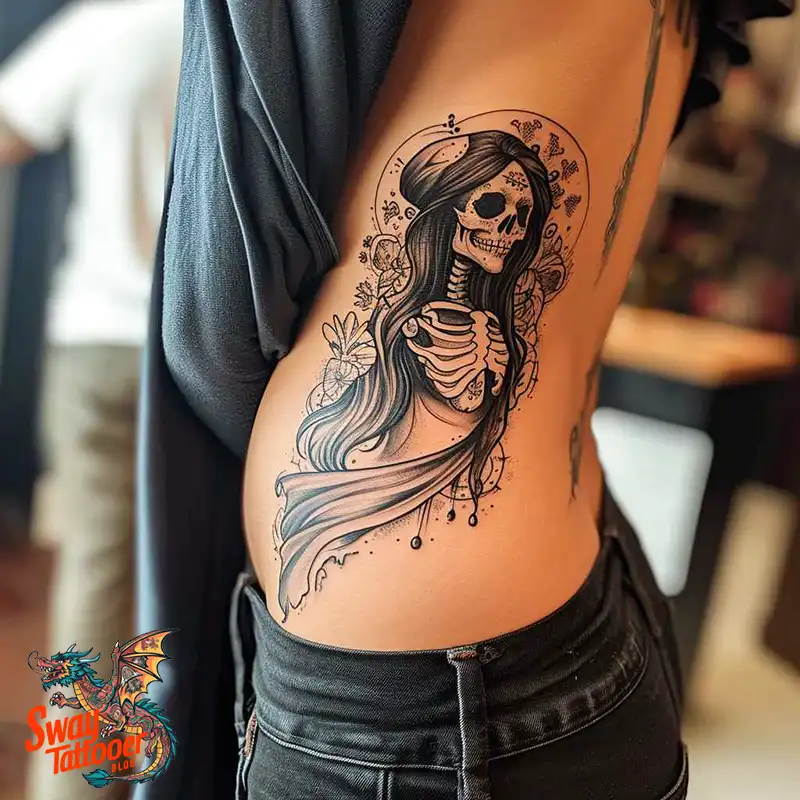
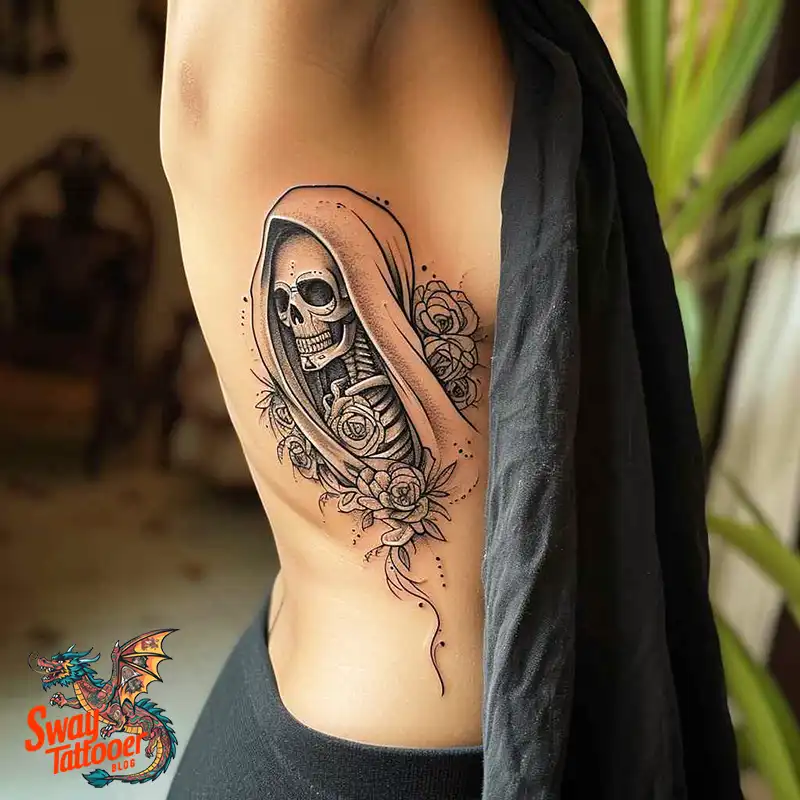
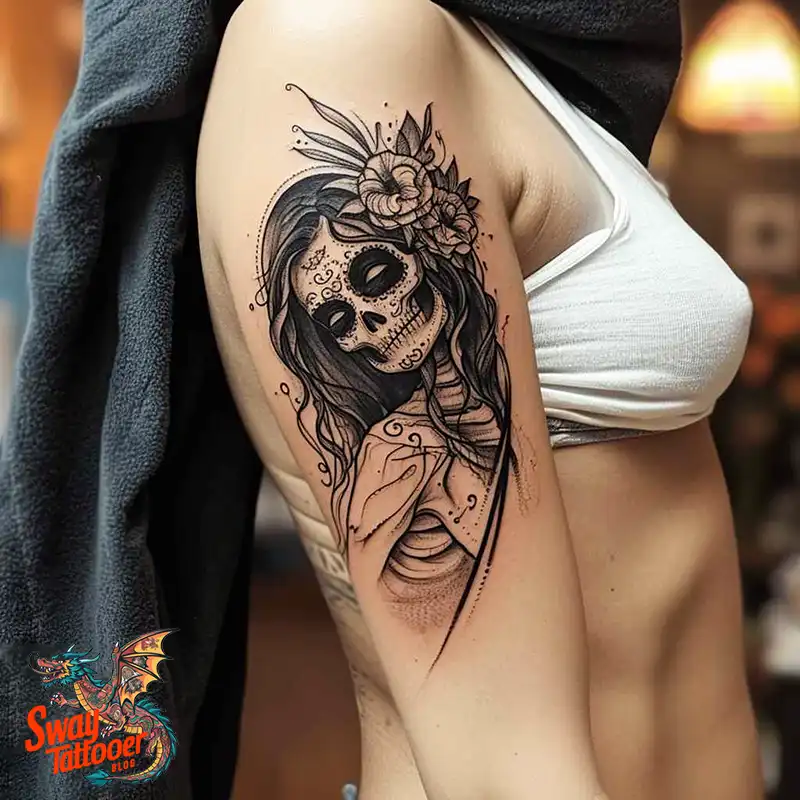
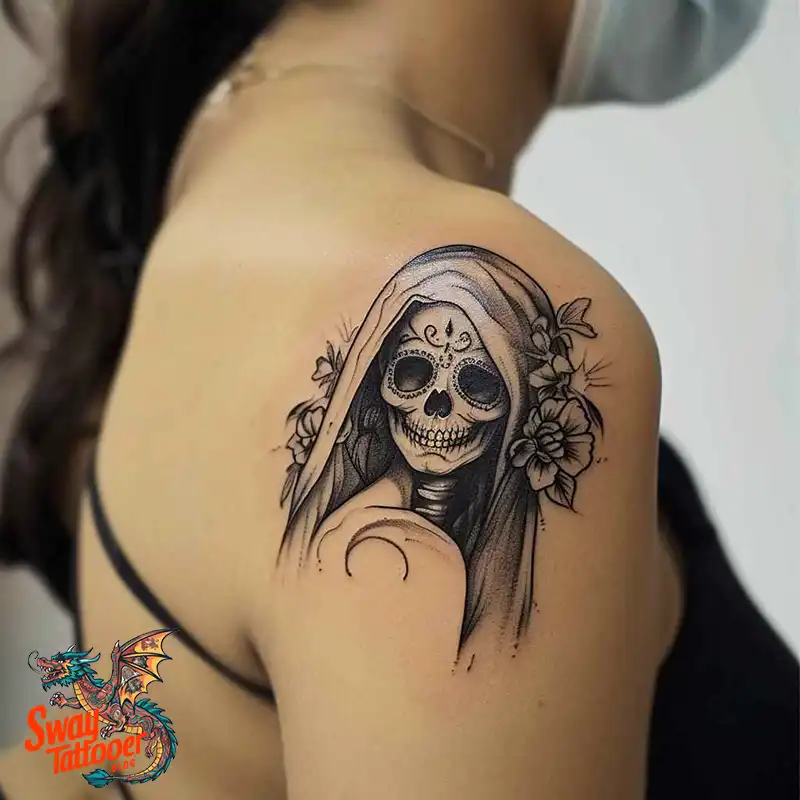
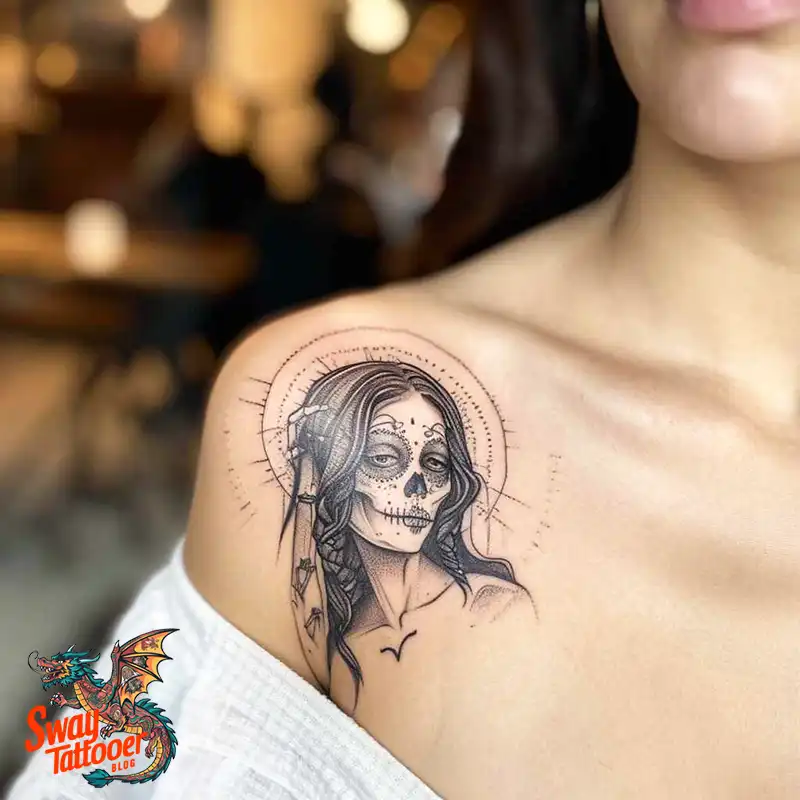

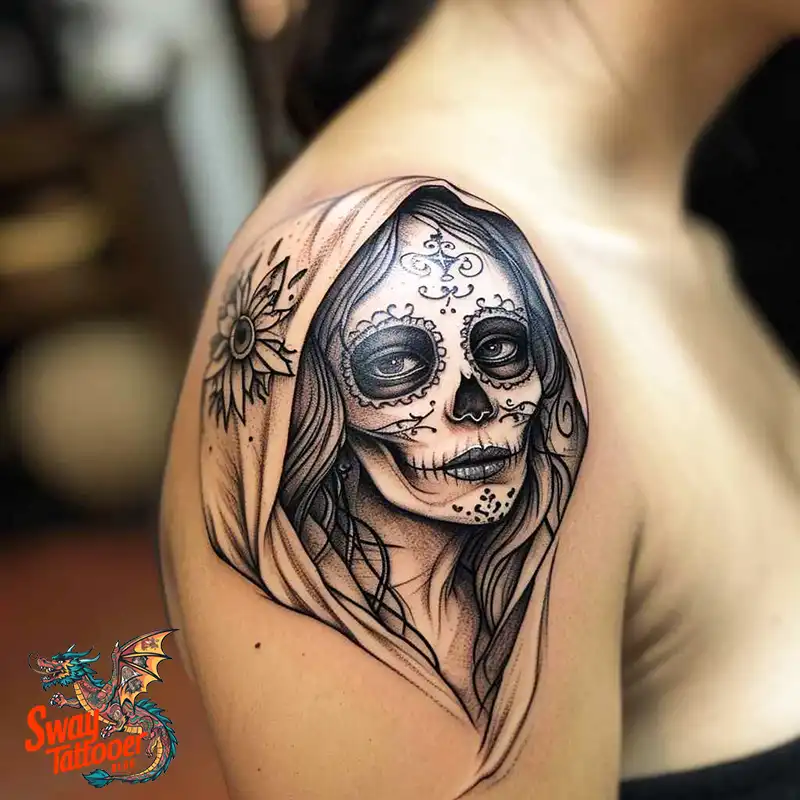
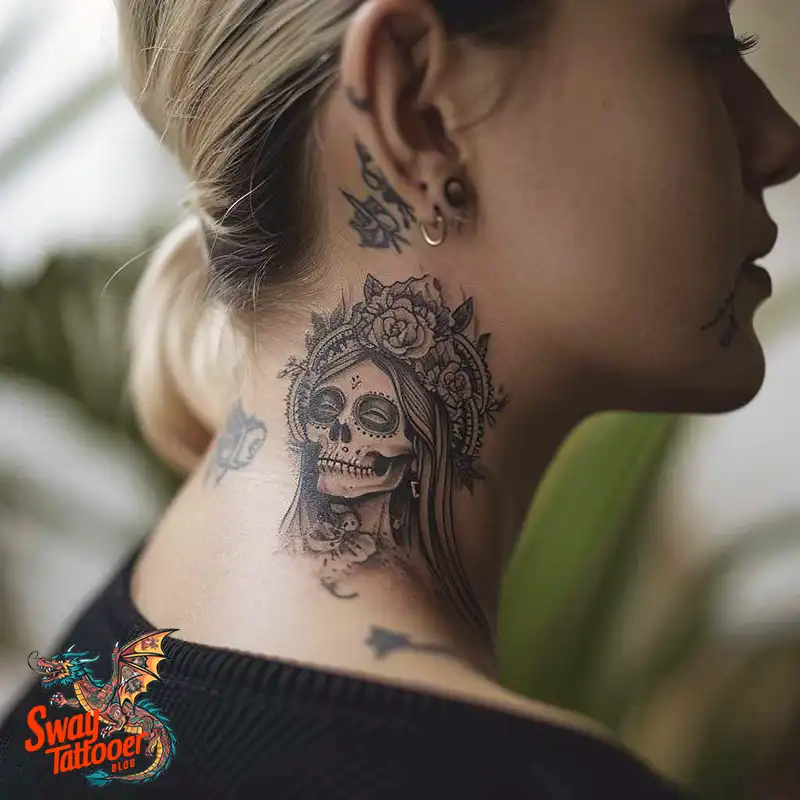
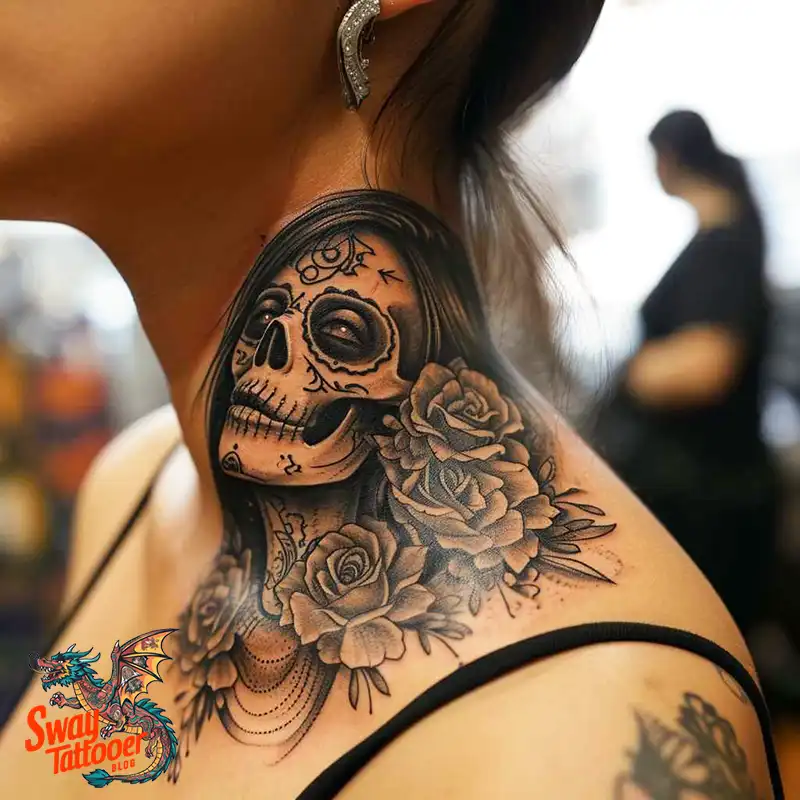
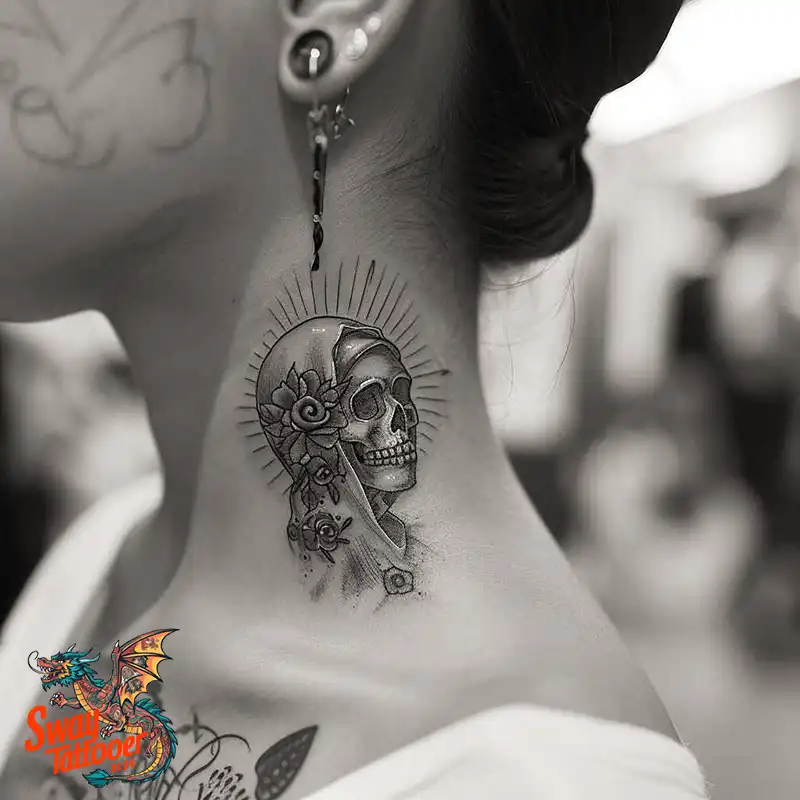
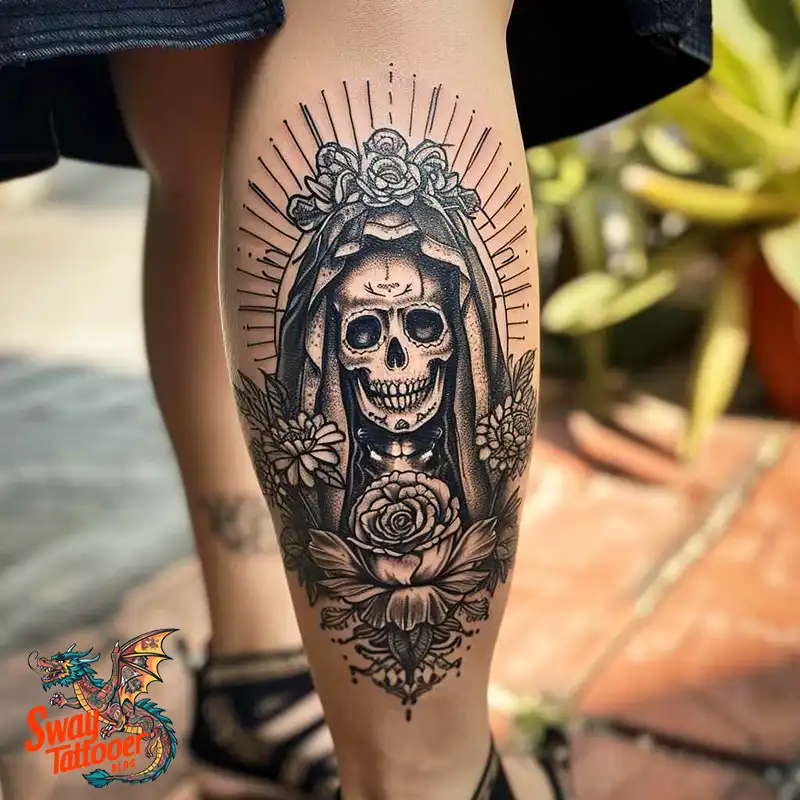

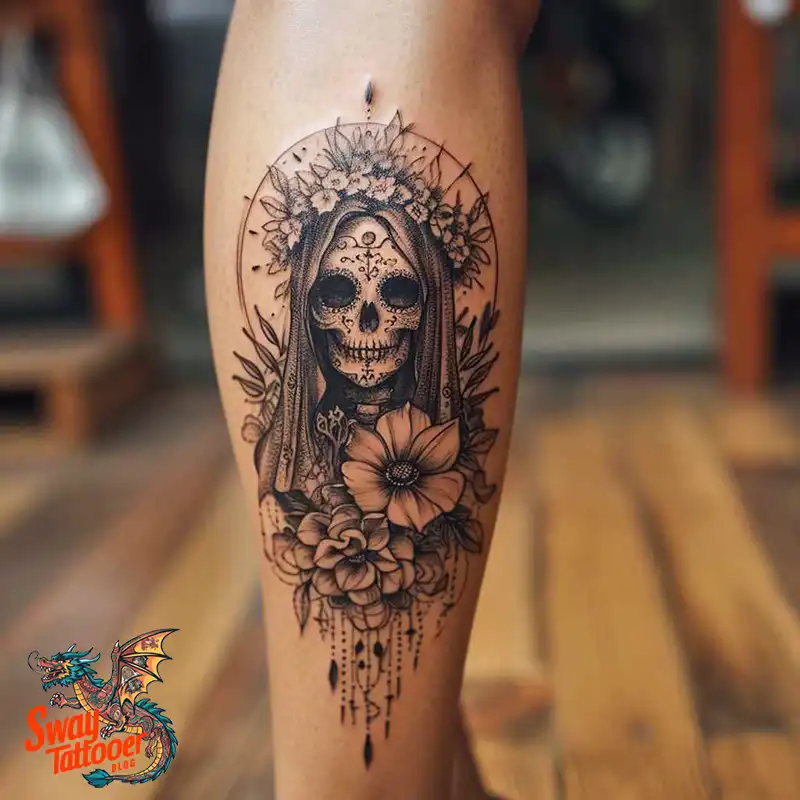
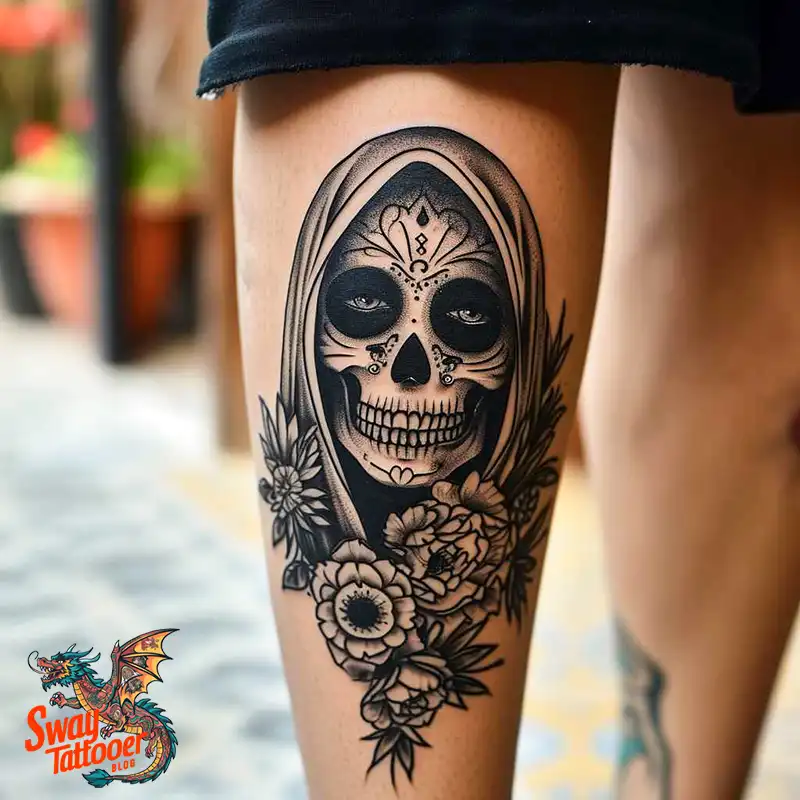
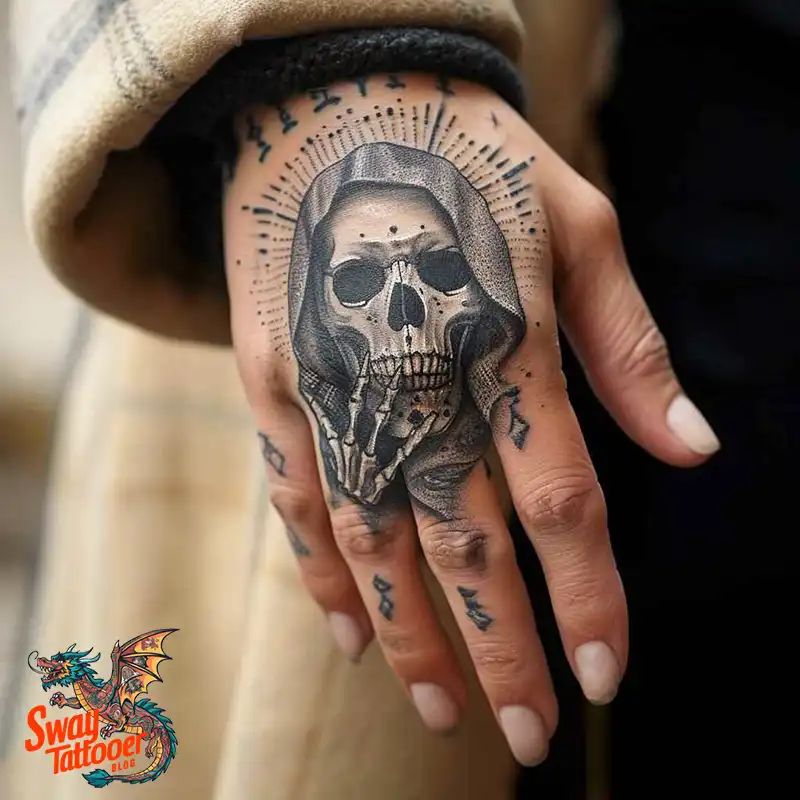
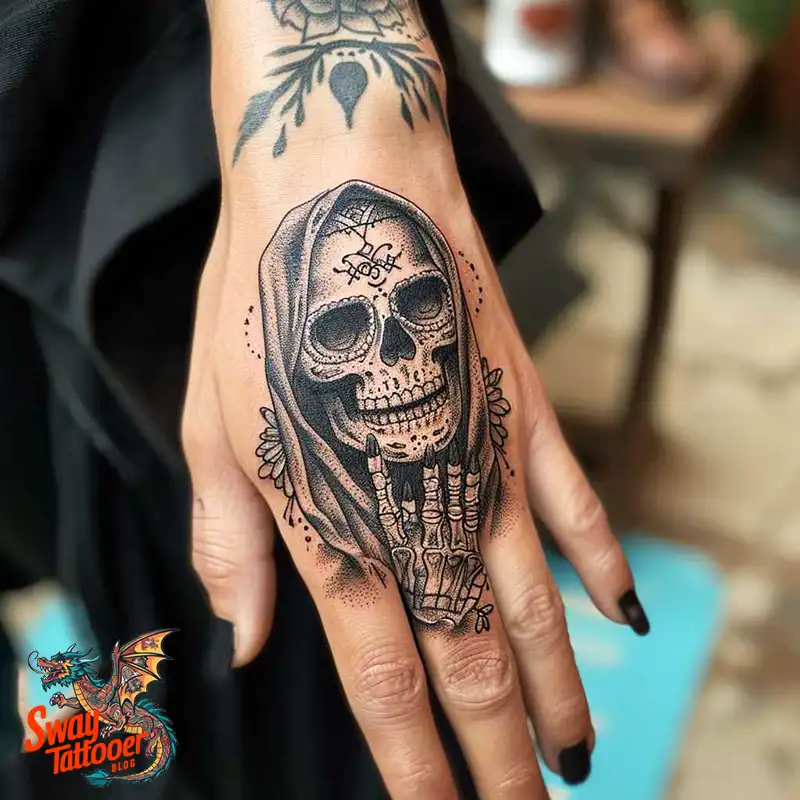
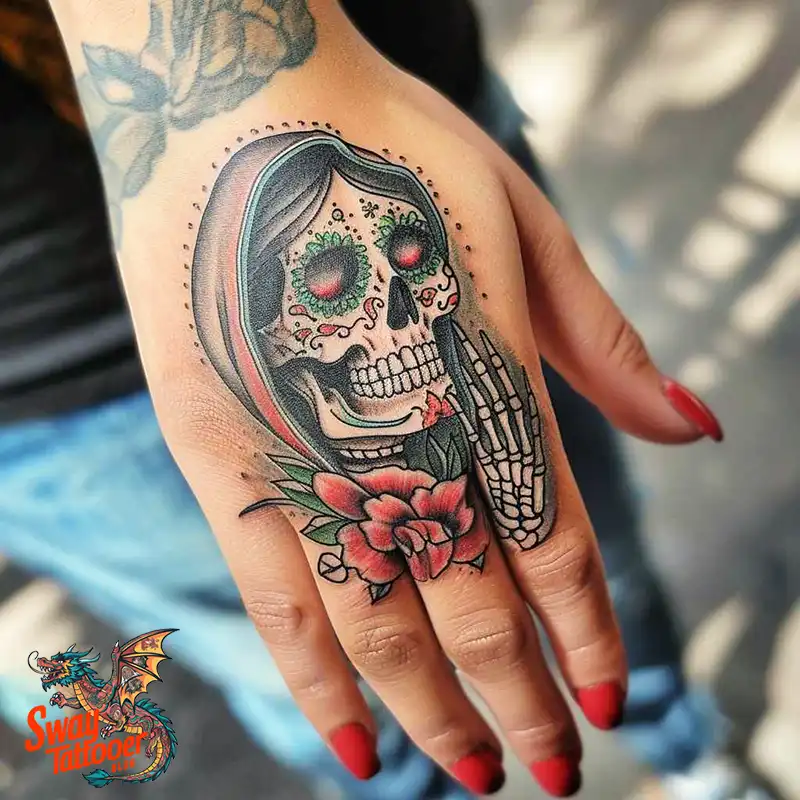
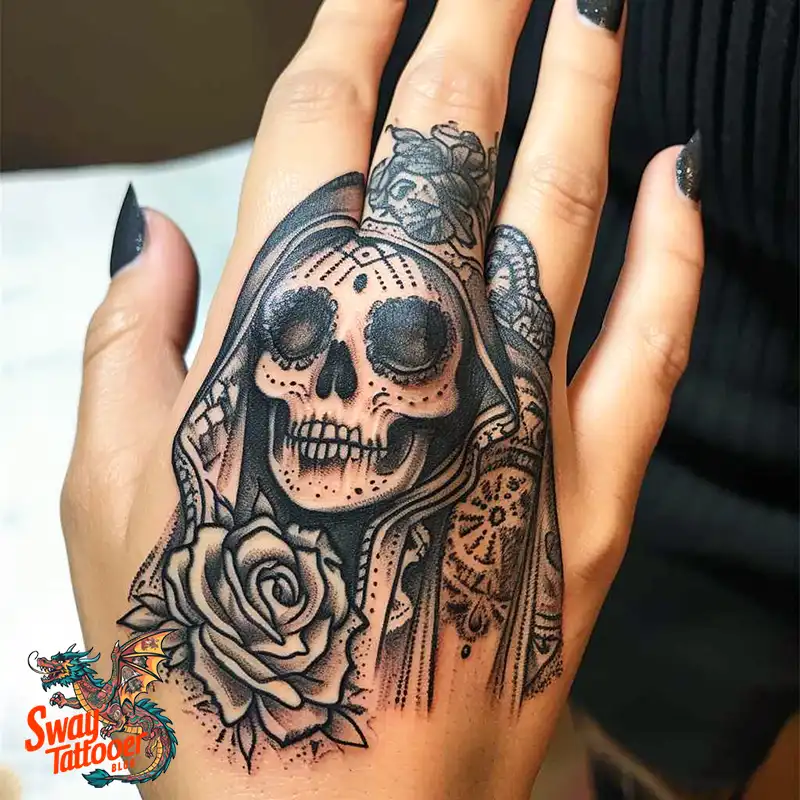
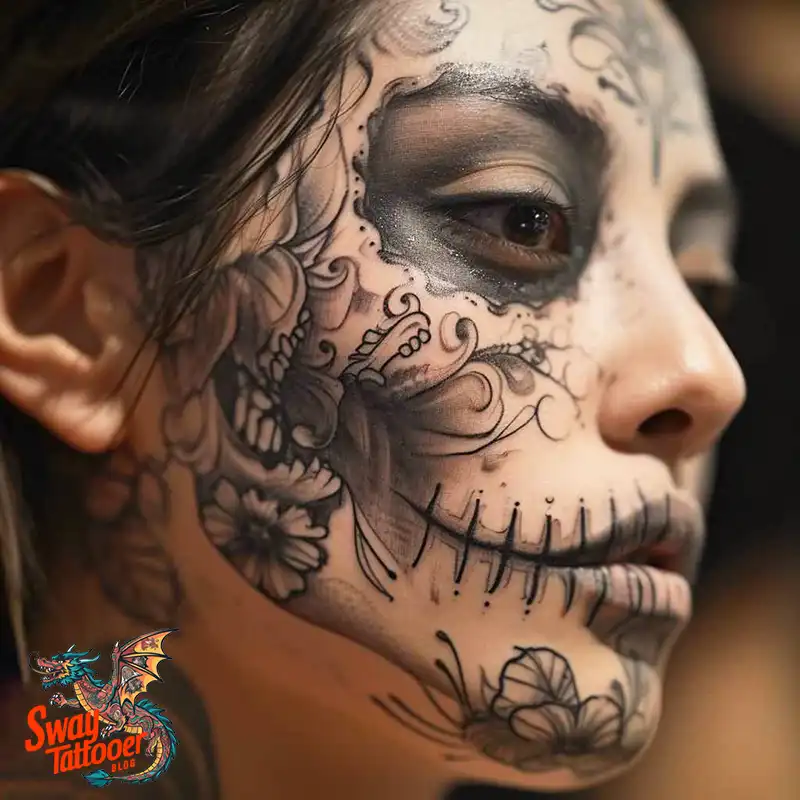

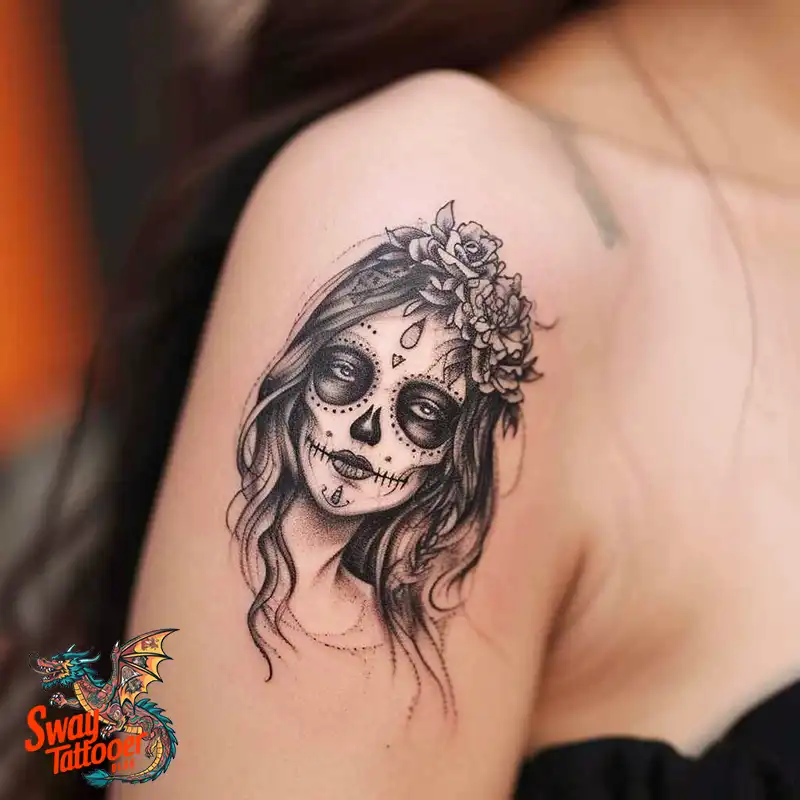
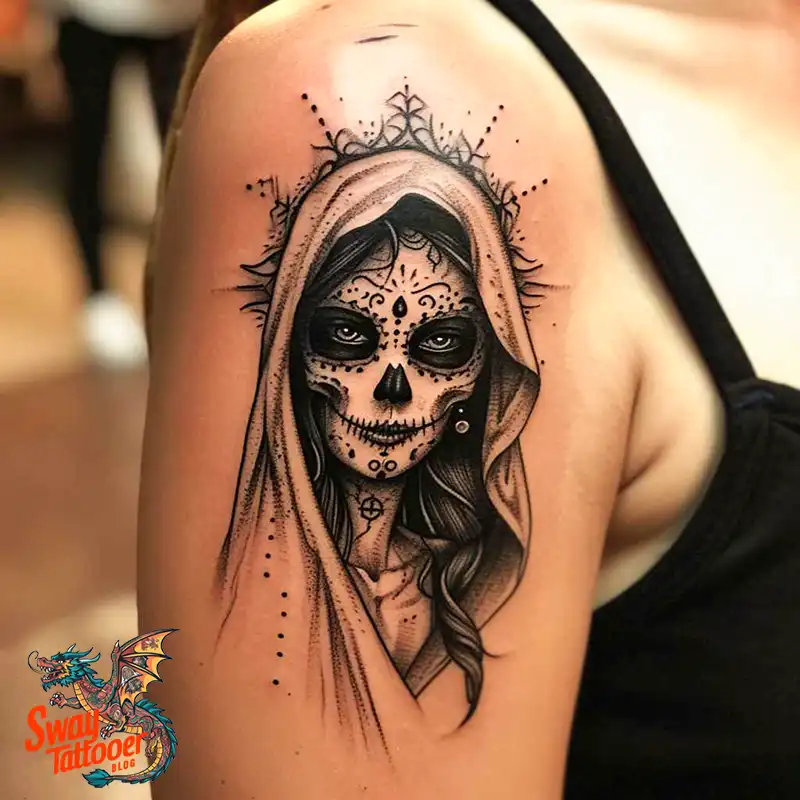
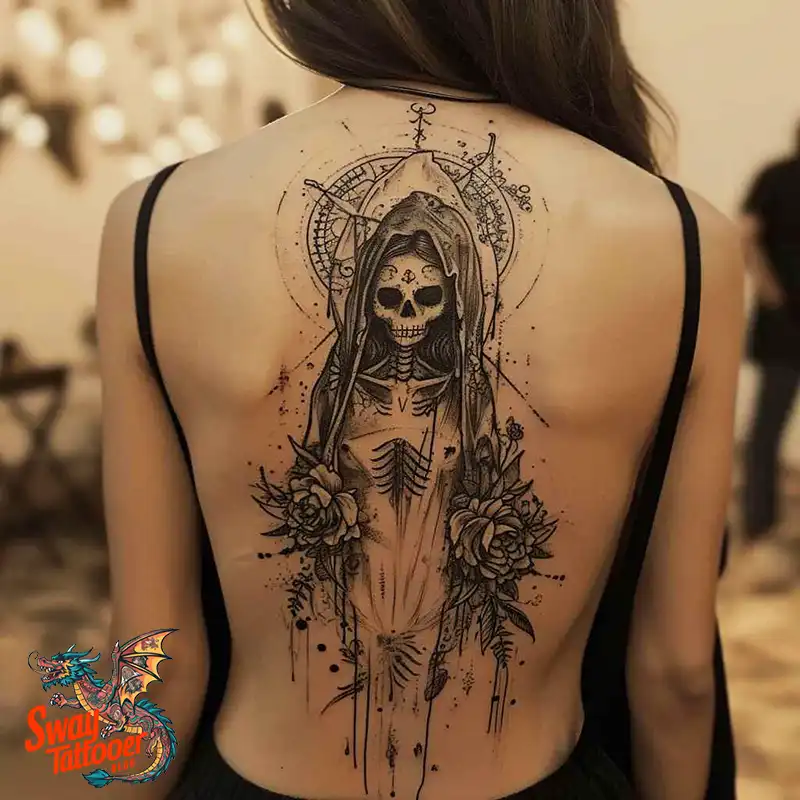
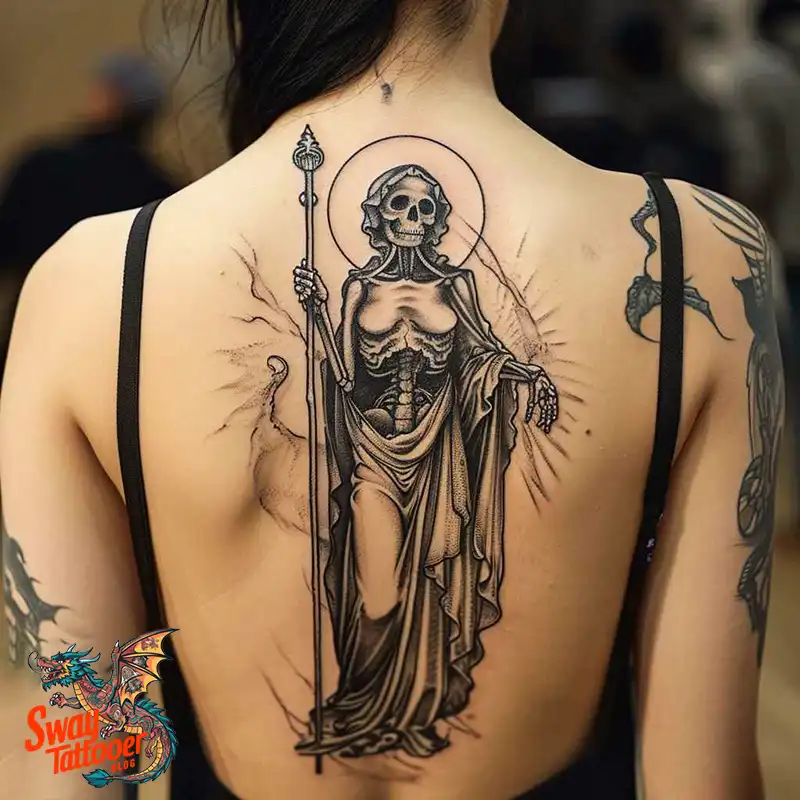
The Allure of La Santa Muerte Tattoos
Tattoos have also served as a means of self-expression by individuals regarding their personal aesthetics, affiliations, and religion. Of all the numerous design possibilities one has in regards to tattoos, the La Santa Muerte tattoo is on lists of cultural icons and artistic depth. Following is the history, symbolisms, as well as current-day allure behind La Santa Muerte tattoos.
Origins of La Santa Muetre
La Santa Muerte, or “Saint Death,” is a popular saint whose cult is widely entrenched in Mexican society. Her background is a bit of a mystery, bringing together elements of pre-Columbian Mesoamerican traditions and Spanish Catholicism. Below is a brief rundown of her origins:
- Aztec Influence: Mictecacihuatl, the goddess of death, was worshiped by the Aztecs as queen of the underworld. Elements of her iconography and worship have passed down to the modern La Santa Muerte figure.
- Syncretism: The arrival of Spanish colonizers introduced Catholicism, and it merged with native spirituality. Syncretism created the unique spiritual environment in which La Santa Muerte emerged.
- Modern Recognition: Although the worship of La Santa Muerte has existed for centuries, it gained broader recognition in the late 20th and early 21st centuries, particularly by marginalized communities seeking solace and protection.
Symbolism Associated with La Santa Muerte Tattoos
La Santa Muerte tattoos are rich in symbolism, an extension of the saint’s own complicated nature. Some of the most important elements are generally depicted:
- The Scythe: Like the Grim Reaper, La Santa Muerte wields a scythe, symbolizing the inevitability of death and cutting the string of life.
- The Globe: Most depictions include a globe, showing her dominion over the entire world and her global influence.
- The Hourglass: This symbolizes passing time and how one should live life to its fullest, since time is short.
- The Robes: La Santa Muerte wears flowing robes in most representations, which can be of varying colors, each bearing a distinct significance:
- White: Purification, safety, and beginnings.
- Black: Energy, magic, and safeguard against evil energies.
- Red: Love, passion, and emotional power.
- Gold: Prosperity, riches, and success.
Popularity and Appeal
The popularity of La Santa Muerte tattoos growing by the day can be attributed to several factors:
- Spiritual Protection: Certain followers are of the opinion that La Santa Muerte provides protection, direction, and assistance in various aspects of life, such as health and prosperity.
- Cultural Identity: For Mexican-born individuals, a La Santa Muerte tattoo can be an influential source of cultural identity and pride.
- Artistic Expression: The elaborate and often dramatic tattoos that envelop La Santa Muerte are a rich canvas for artistic expression.
- Empowerment and Rebellion: La Santa Muerte is most often revered by those who feel peripheral or excluded from mainstream society. Her existence represents spiritual rebellion and empowerment.
Designing a La Santa Muerte Tattoo
When considering the ink of a La Santa Muerte tattoo, there are several design elements to take into account:
- Placement: Common locations for La Santa Muerte tattoos include the back, arms, chest, and legs. Placement can have a significant impact on the size and detail of the tattoo.
- Style: The artists may opt for traditional black and grey realism, colorful work, or even abstract and surreal representations.
- Personal Aspects: Including personal symbols or messages will also increase the meaning of the tattoo. This could be the name of a loved one, dates of importance, or particular motifs that hold relevance to the history of the individual’s life.
Cultural Sensitivity and Respect
Cultural sensitivity and respect must be maintained in La Santa Muerte tattoos:
- Understanding: Spend time to understand her cultural and religious significance prior to getting a La Santa Muerte tattoo. It will turn the tattoo into more than a simple visual choice but a respectful homage.
- Advice: Discussing with somebody acquainted with La Santa Muerte, i.e., a believer or a scholar, can provide better insight and avoid potential cultural blunders.
- Dignified Artists: Choose a tattoo artist who is not only skilled but also respectful of the cultural and spiritual meaning of images of La Santa Muerte.
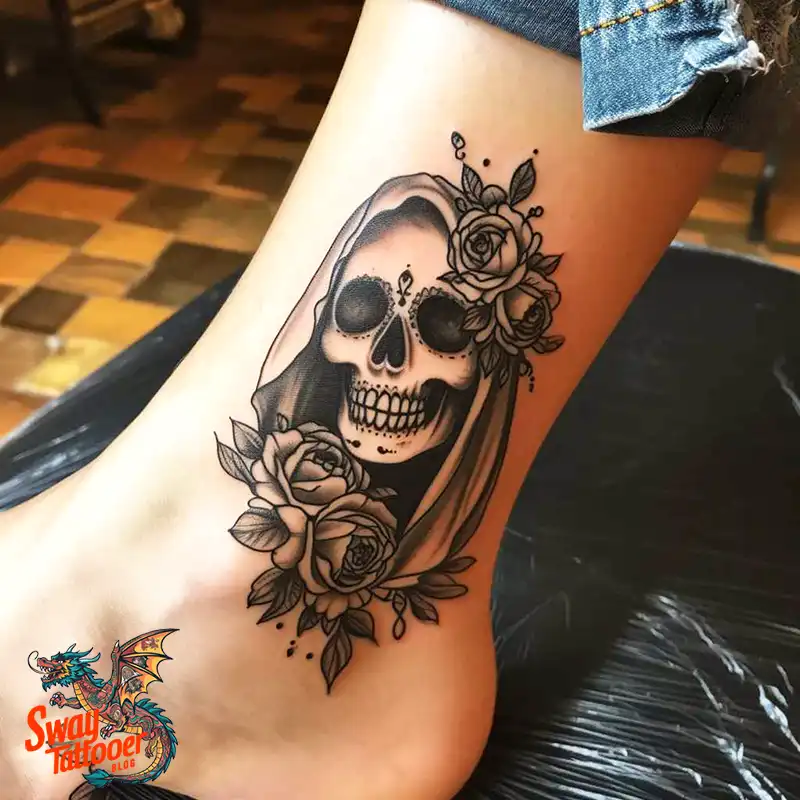
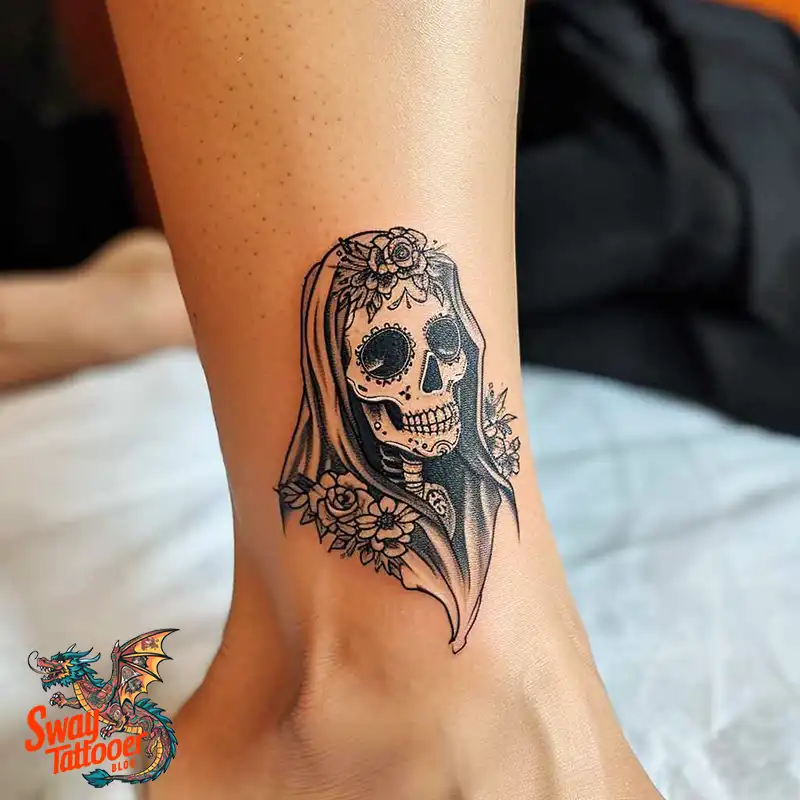
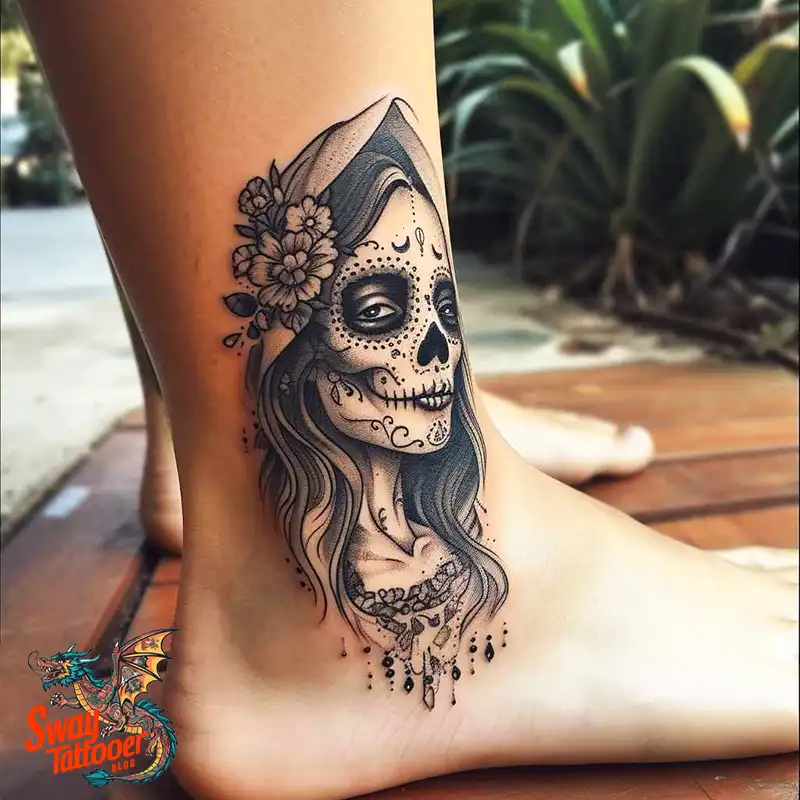
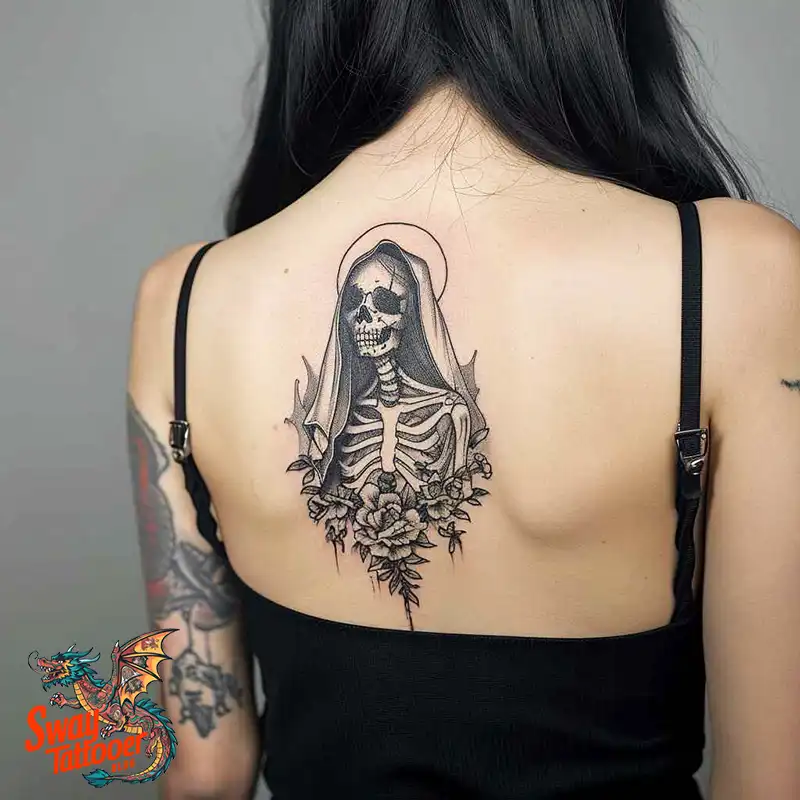
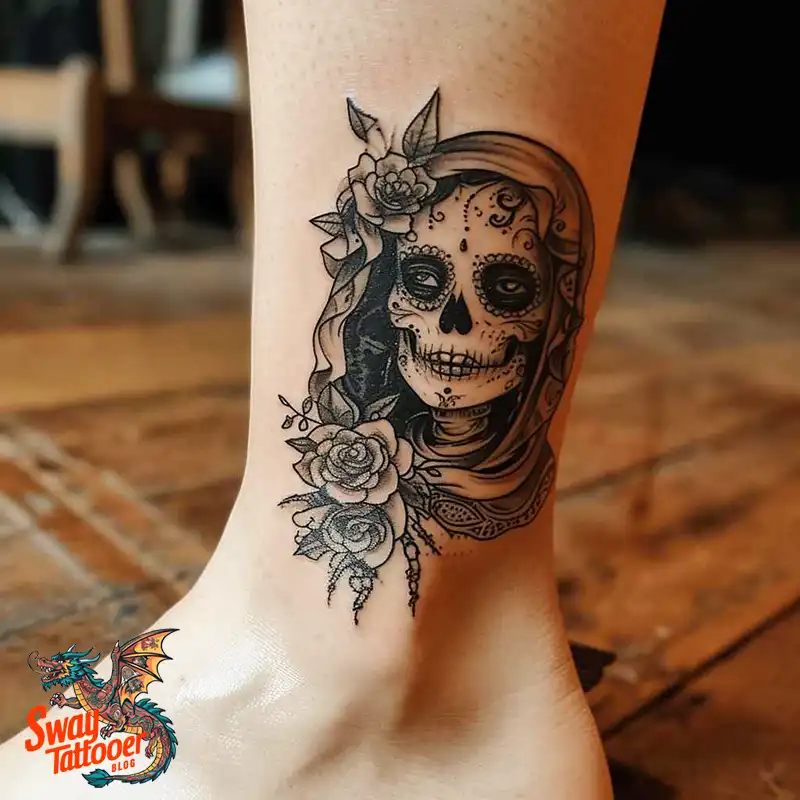
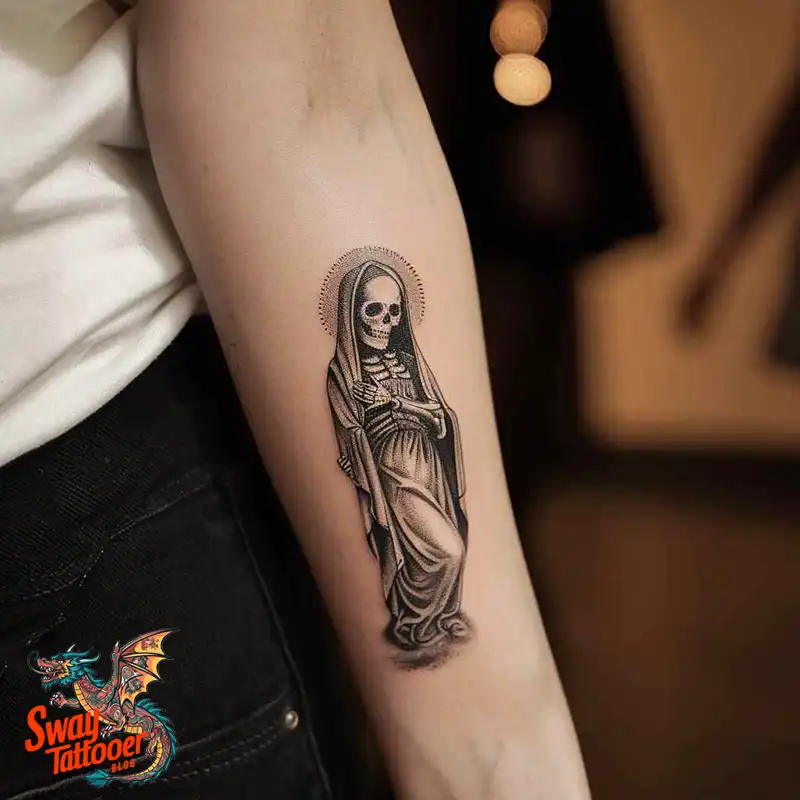
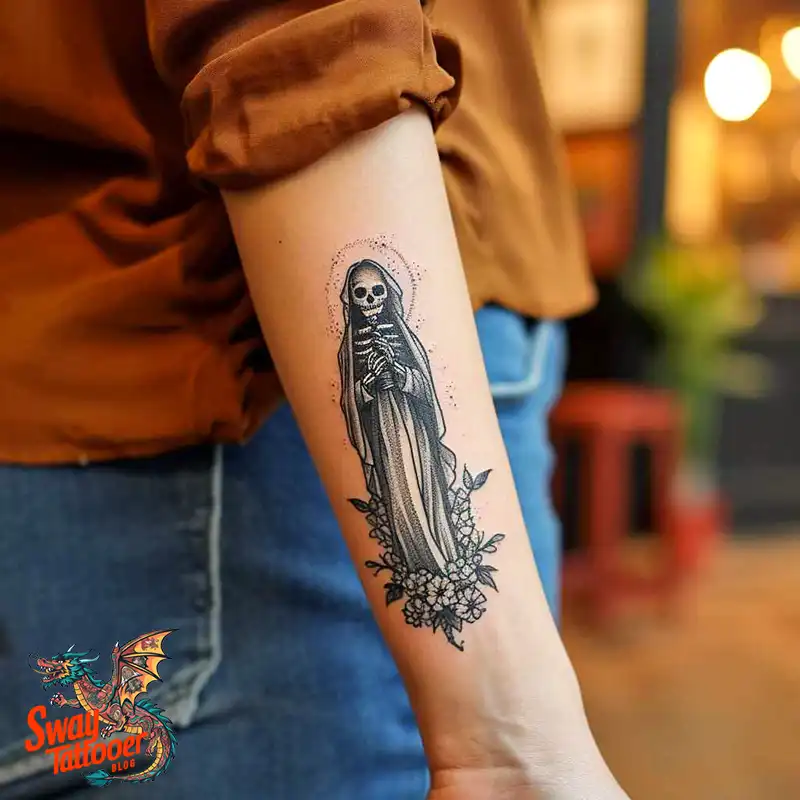
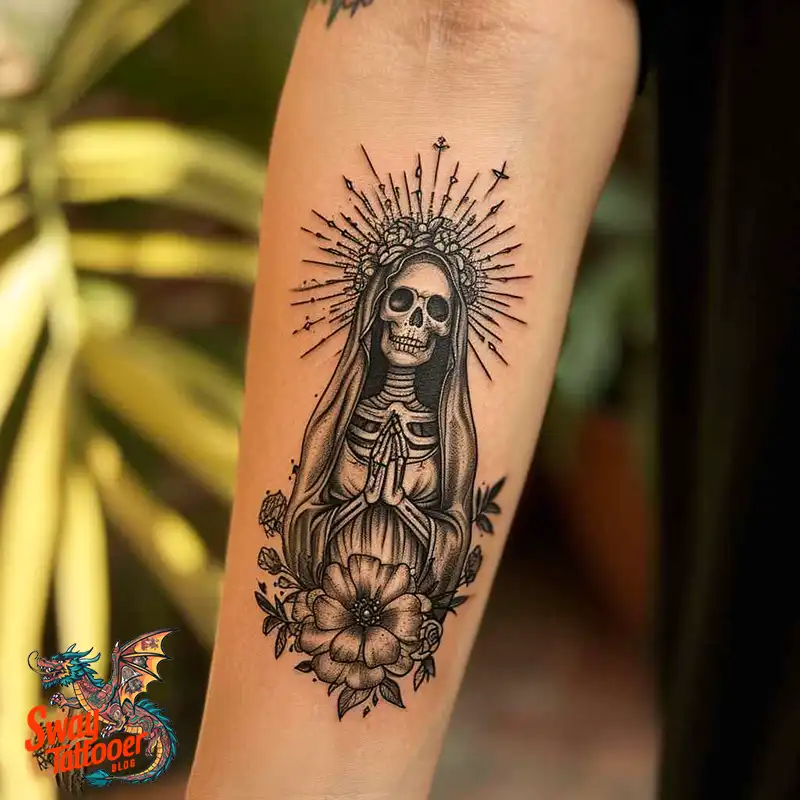
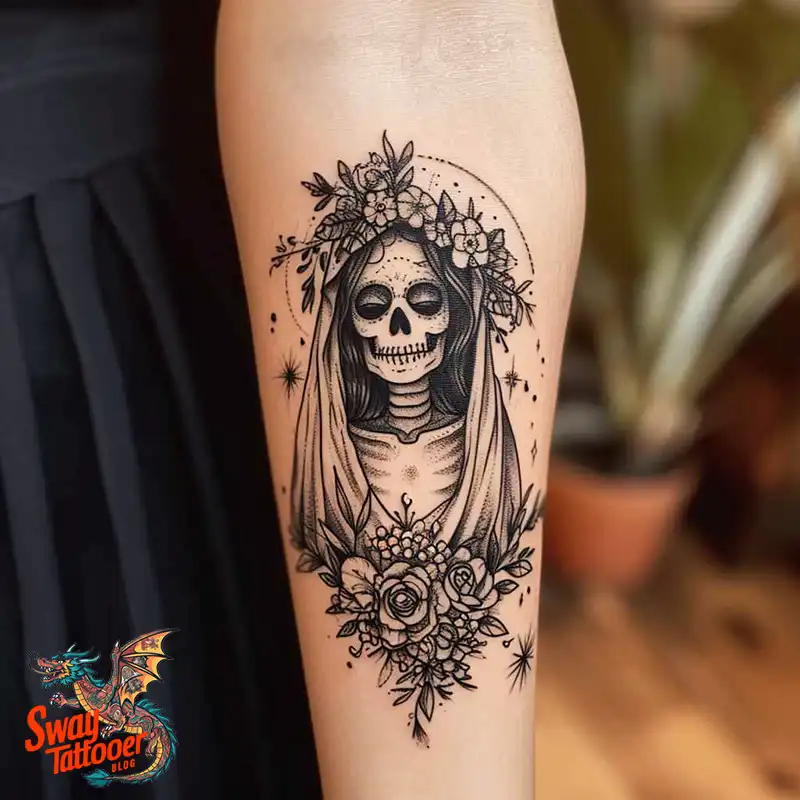
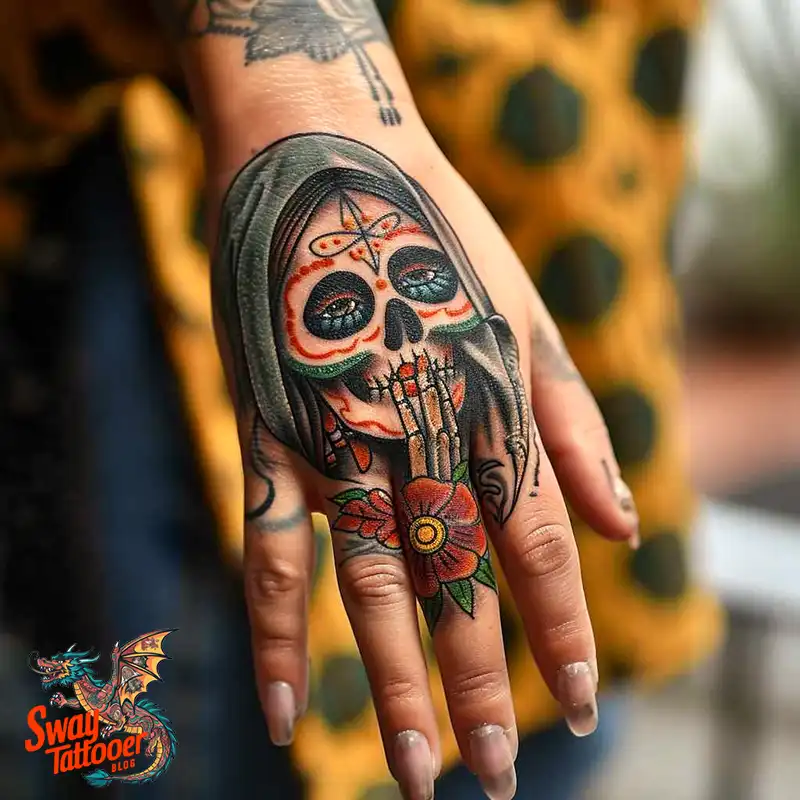
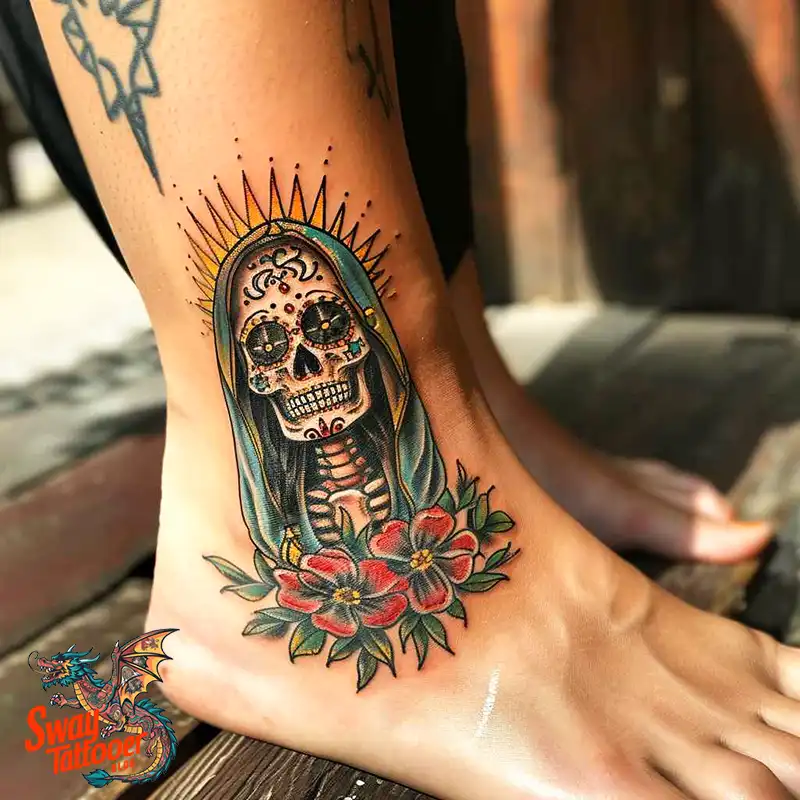
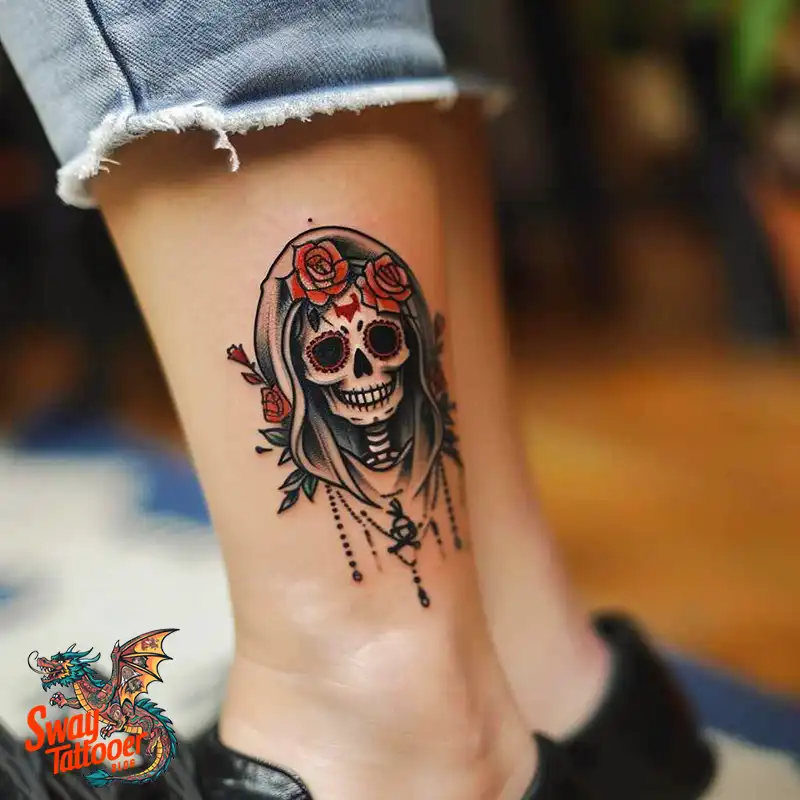
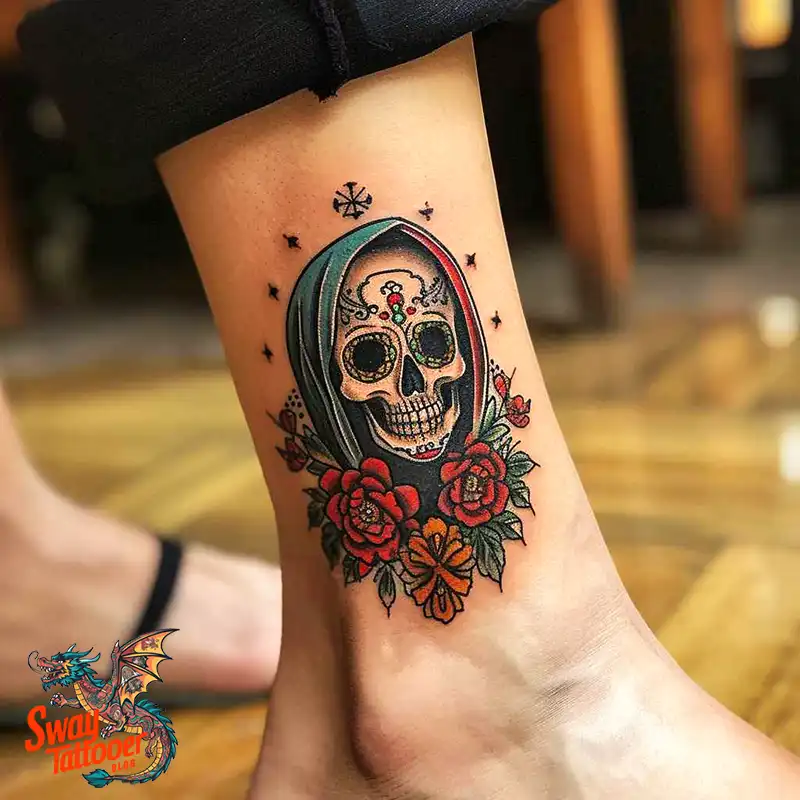
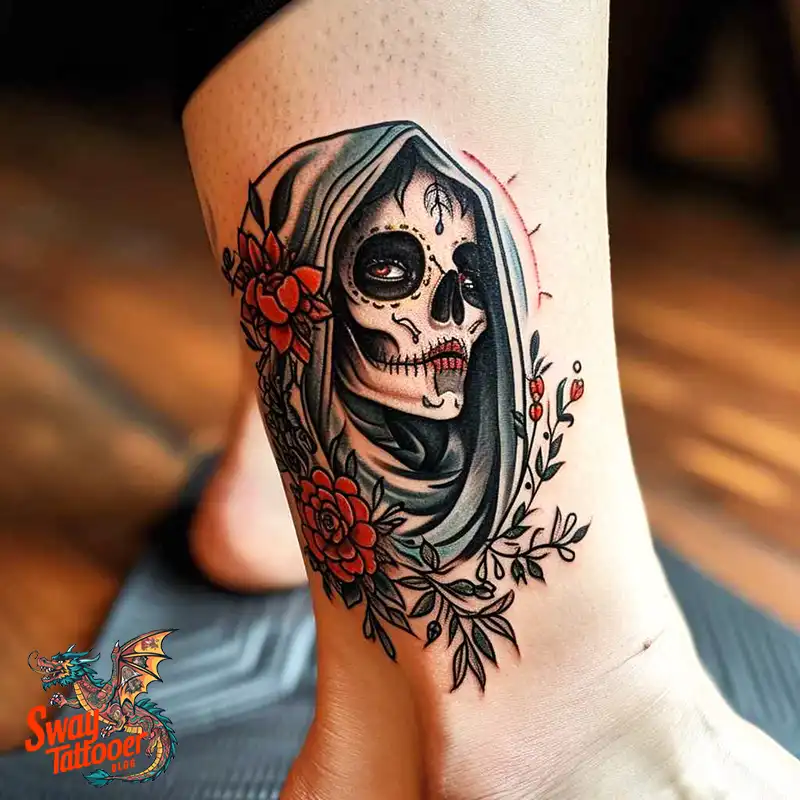

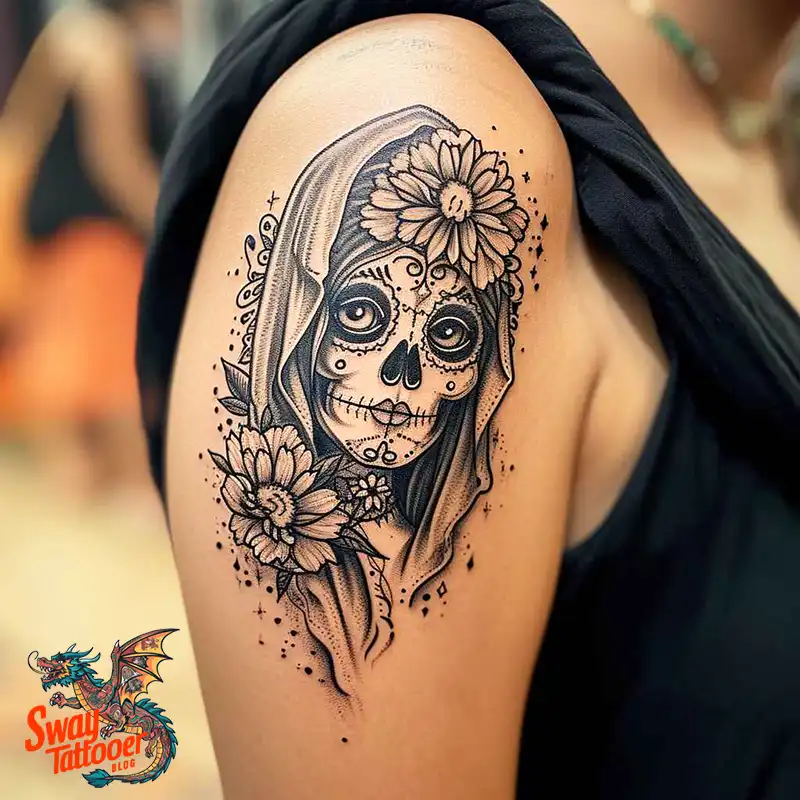
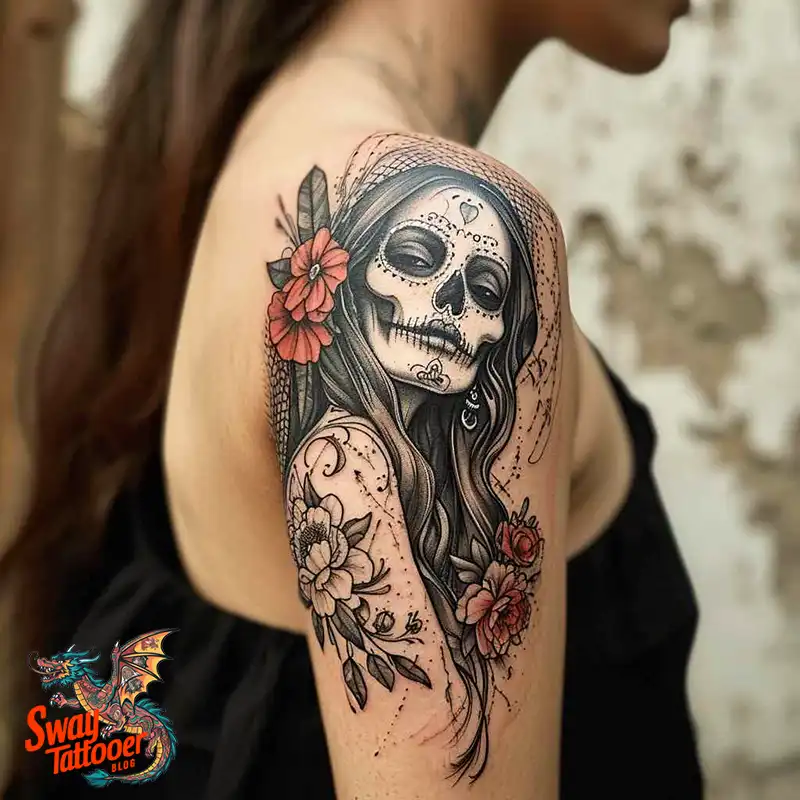
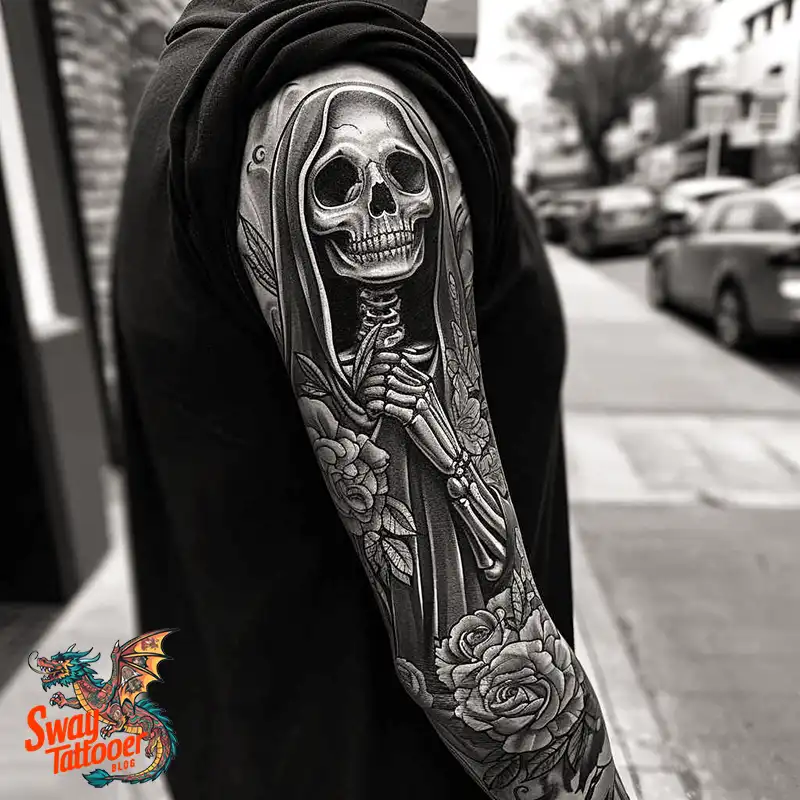
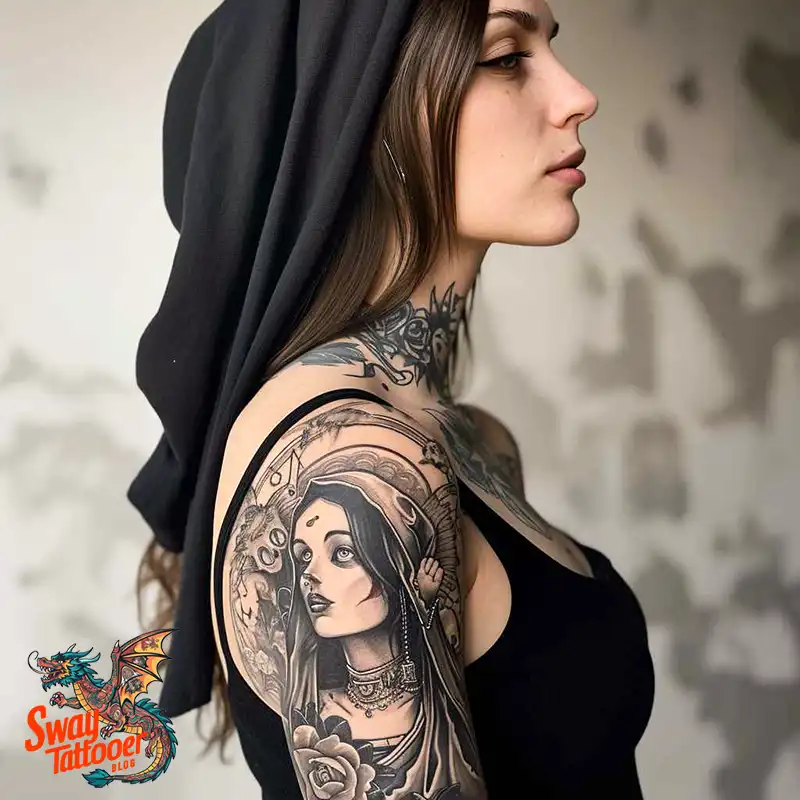
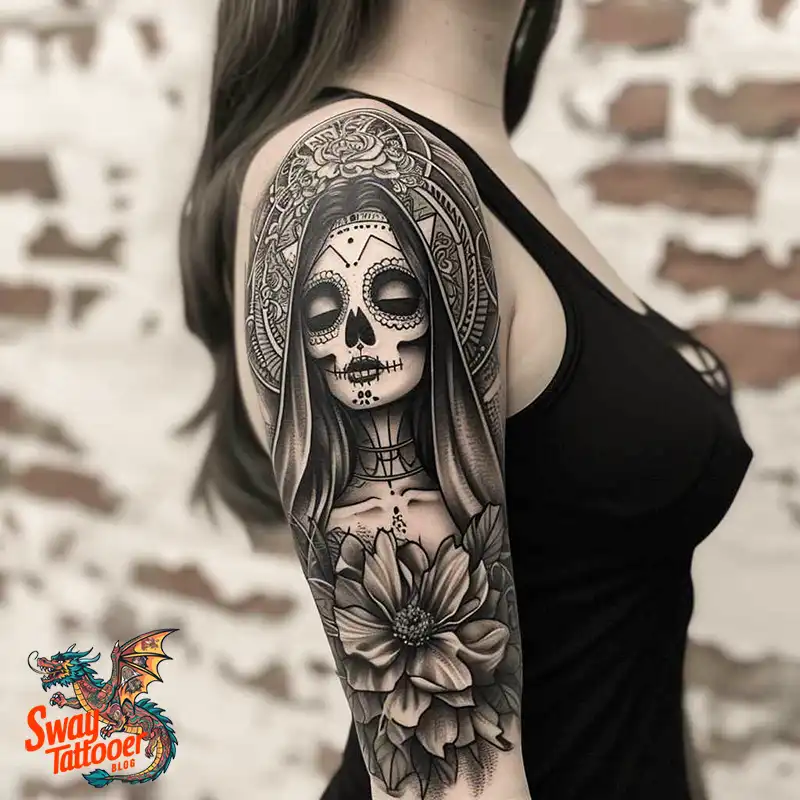
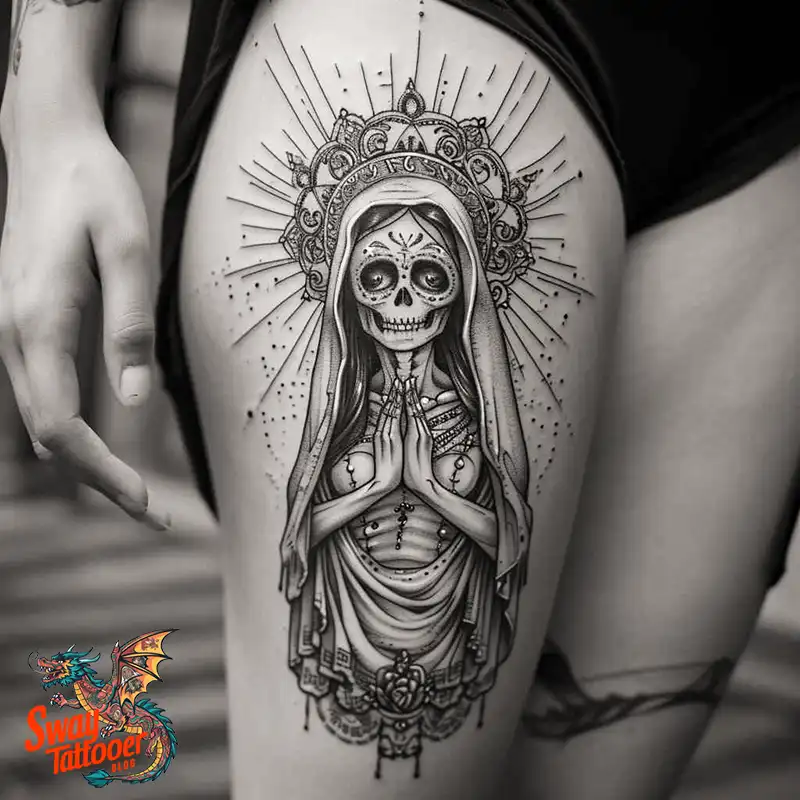

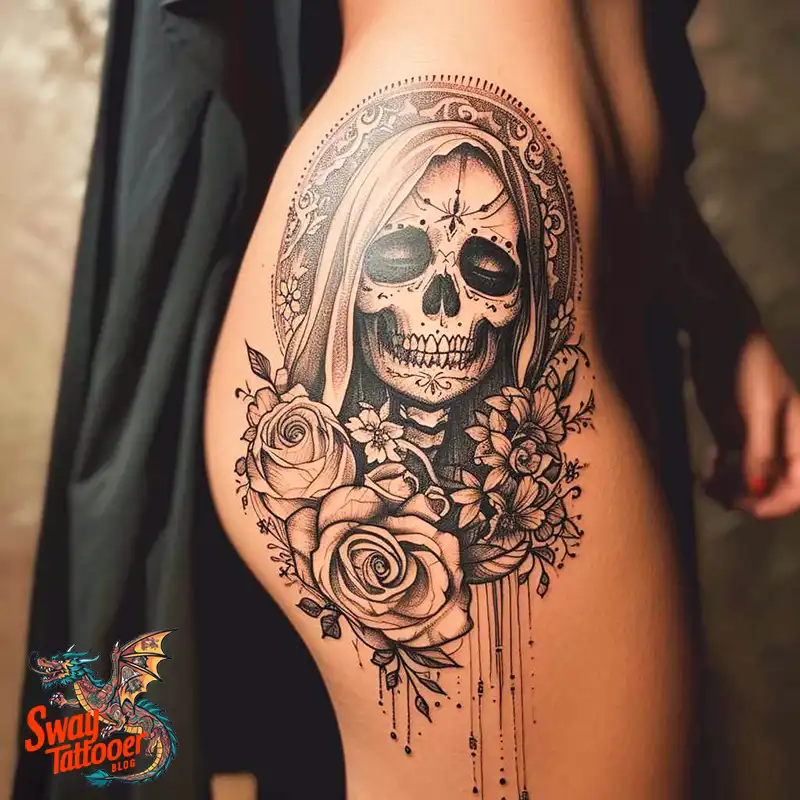
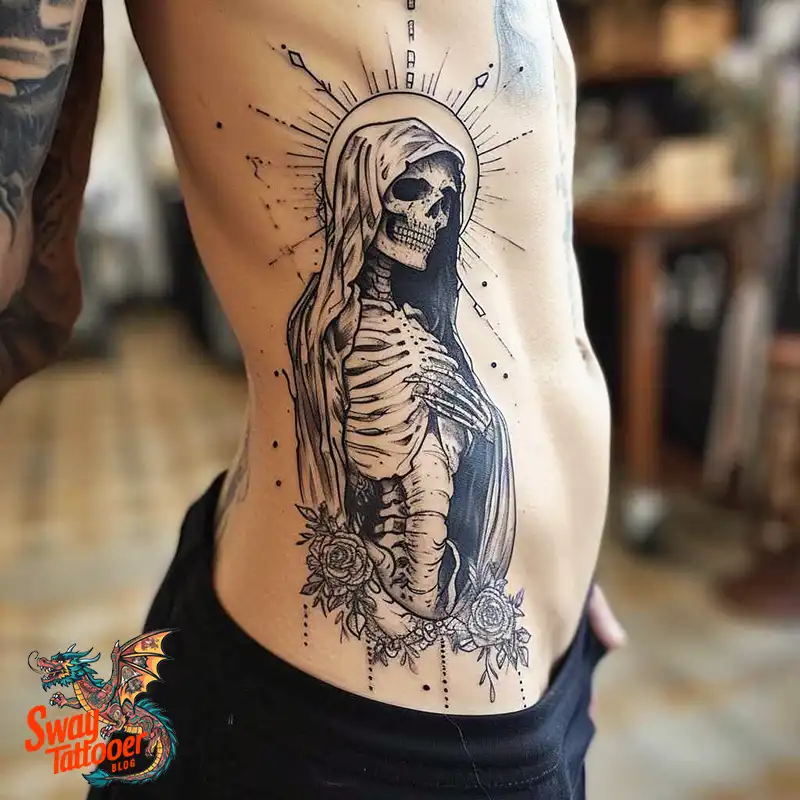
Different Types of La Santa Muerte Tattoos
La Santa Muerte, or Our Lady of Holy Death, is a folk saint revered primarily in Mexico and by Hispanic Americans in the United States. She is typically depicted as a skeleton and is considered to be a personification of death. This photograph is filled with rich, culturally embedded symbolism, blending indigenous religious traditions, Catholicism, and contemporary spirituality. The majority of individuals get her image tattooed on their bodies as a sign of respect or as a way to invoke her protection. Let’s examine some of the different La Santa Muerte tattoo styles and how they connect:
1. Traditional Skeleton Figure
Summary: La Santa Muerte is depicted in this design as a skeleton, usually depicted in a robe and holding a scythe. The skeletal depiction is a morbid reminder of death.
Relevance: The skeletal figure is a memento mori, a Latin expression that means “remember that you have to die.” It is a reminder of the inevitability of death, which reminds the wearer of the importance of living a purposeful and reverent life toward the cycle of life and death.
2. La Santa Muerte with Scales of Justice
Summary: The Santa Muerte here is shown holding the scales of justice, symbolizing justice and balance.
Relevance: To others, this symbolizes the equity of death, which comes to all regardless of status, race, or creed. It also symbolizes individual commitment to justice and equity in life.
3. Color-Coded Robes
Summary: La Santa Muerte is typically depicted wearing robes of various colors, each representing various aspects of life or powers she wields. The typical colors are white, black, red, green, and gold.
Relevance: Each color has some association:
- White: Purity, protection, and healing.
- Black: Power, protection, and elimination of negative energies.
- Red: Love, passion, and strength.
- Green: Justice, legal matters, and prosperity.
- Gold: Wealth, success, and personal development.
These tattoos allow the wearer to invoke some aspects or blessings they wish from La Santa Muerte.
4. La Santa Muerte with Roses
Summary: This tattoo design includes the skeletal figure of La Santa Muerte with roses, typically around her or in her hands.
Relevance: Roses remind one of the beauty and impermanence of life. The tattoo can symbolize the duality of life and death, beauty in decay, and the combination of the temporary pleasures of life and the inevitability of death.
5. Day of the Dead (Día de los Muertos) Influence
Summary: The design might include elements of the Día de los Muertos celebration, such as sugar skulls, marigolds, and fiesta decorations.
Relevance: The Day of the Dead is a celebratory day for remembering deceased loved ones. This tattoo design may be a celebration of life, a tribute to the deceased, and an acknowledgment that death is an inevitable process.
6. La Santa Muerte and Hourglass
Summary: In this tattoo, La Santa Muerte stands or holds an hourglass, symbolizing the passage of time.
Relevance: The hourglass represents the temporariness of life and the urgency to make every moment count. It serves as a reminder of the transience of life and the importance of living each day to the fullest.
7. La Santa Mueste with Cross
Summary: La Santa Muerte may be depicted with a cross, blending Christian imagery with her distinctive symbolism.
Relevance: This style highlights the syncretism of Catholicism and La Santa Muerte worship. It may symbolize the wearer’s faith, protection, and synthesis of different spiritual practices.
8. Modern Interpretations
Summary: Modern interpretations of La Santa Muerte may include more abstract designs, minimalist styles, or a fusion with other modern tattoo styles.
Relevance: The designs show how La Santa Muerte’s imagery evolves and is adapted to fit contemporary art forms. They are indicative of the wearer’s individual and contemporary religious journey.
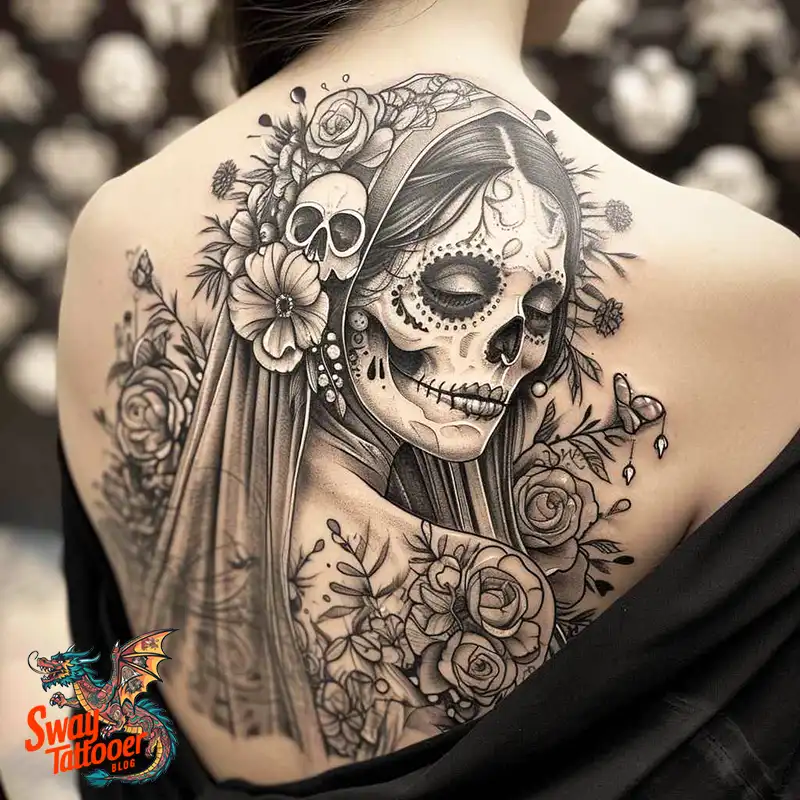
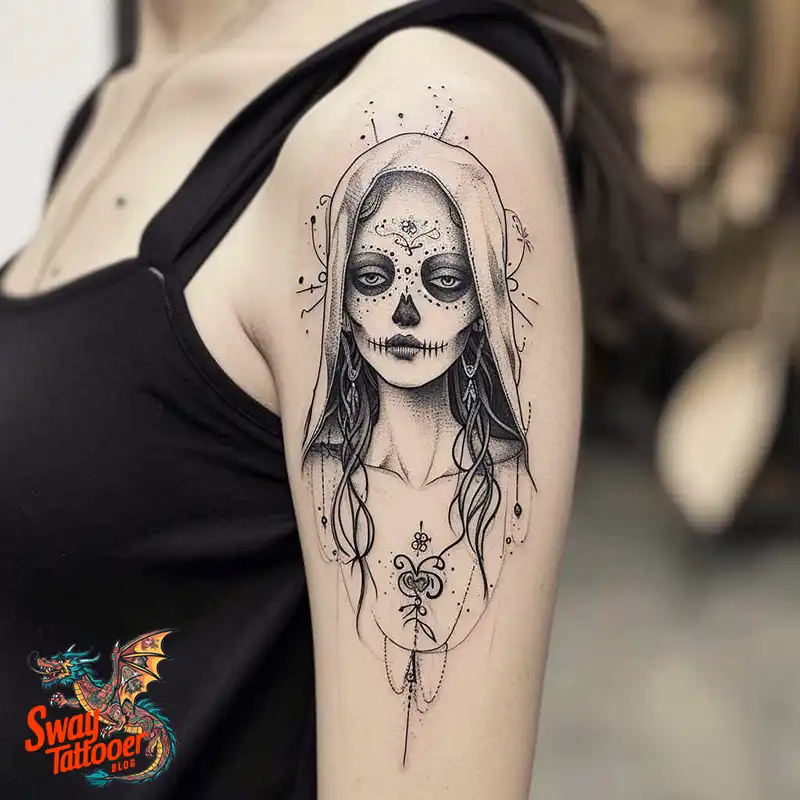
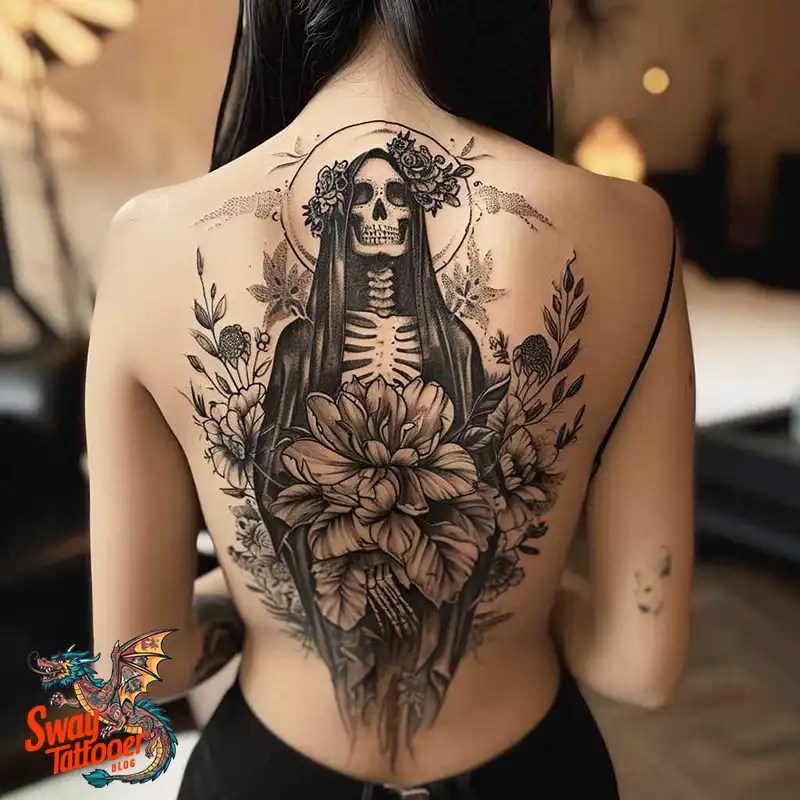
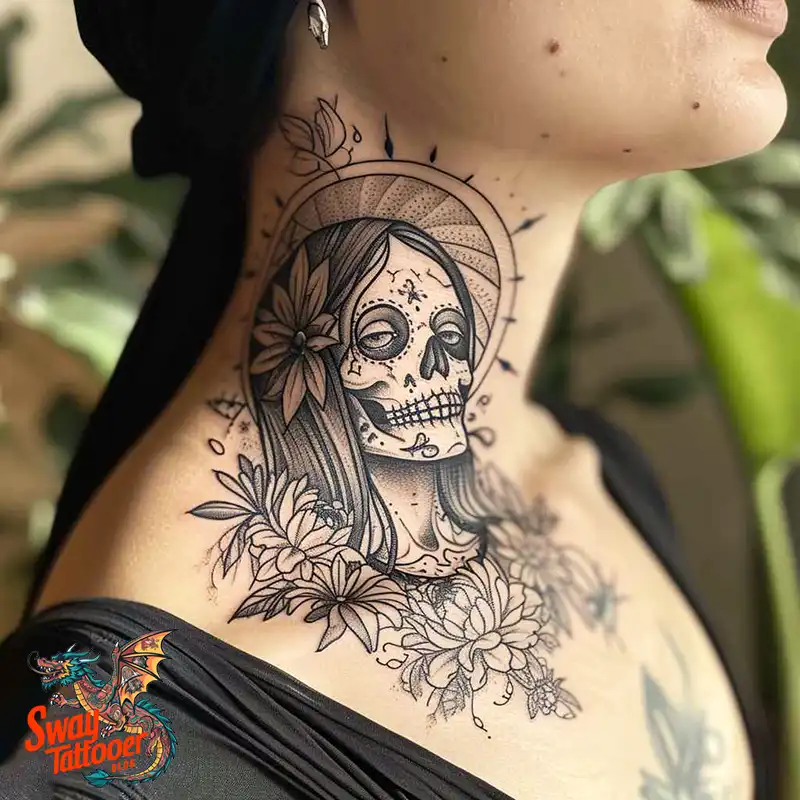
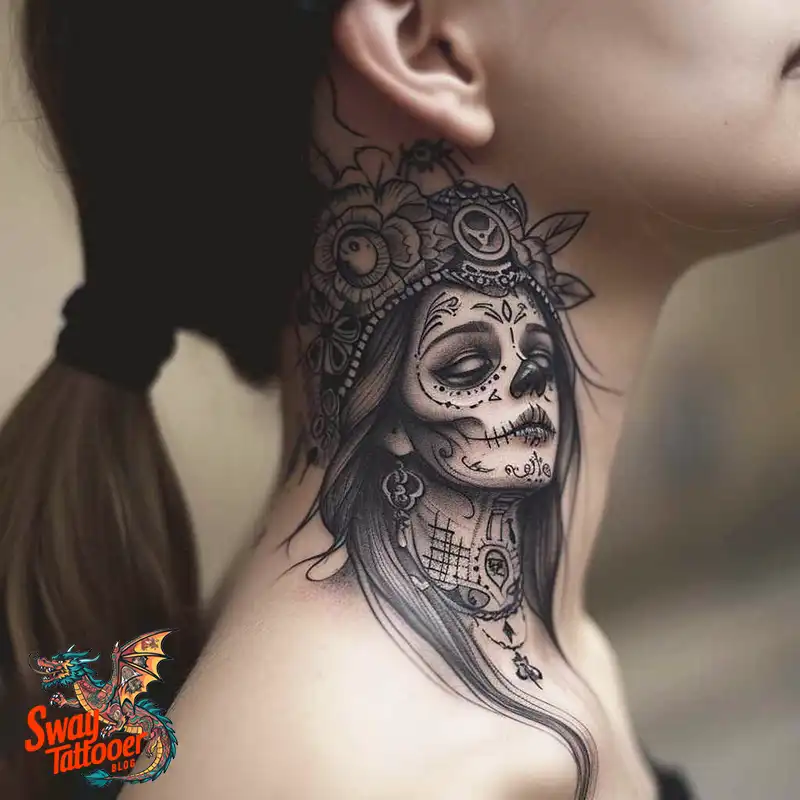
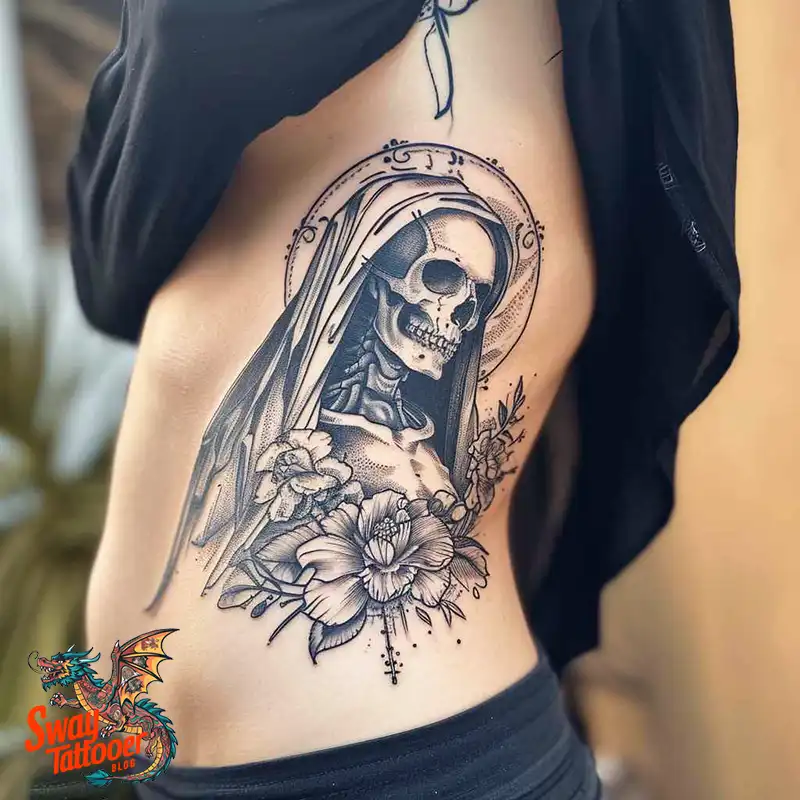
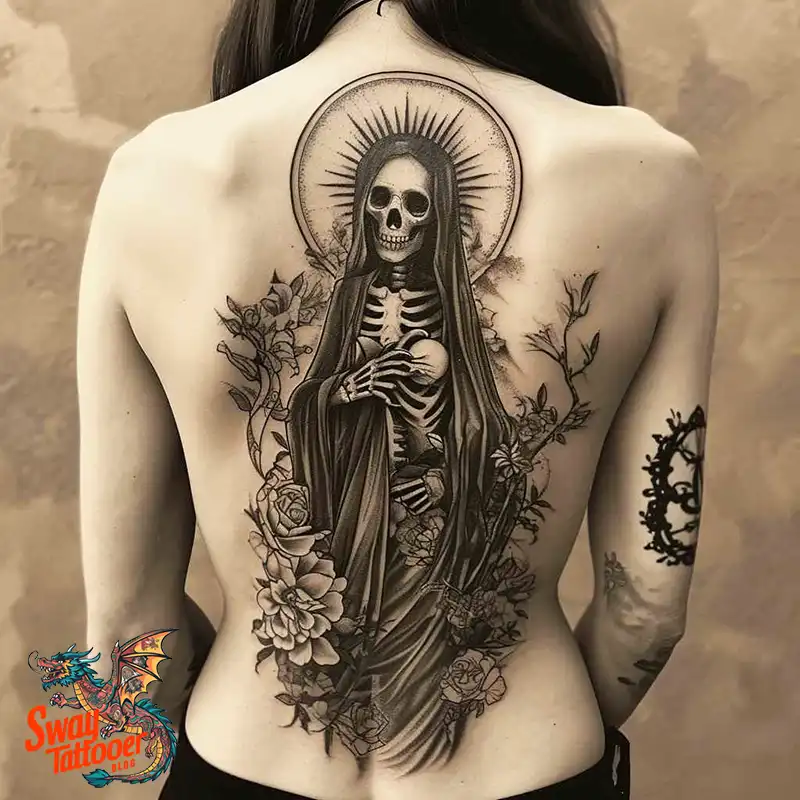

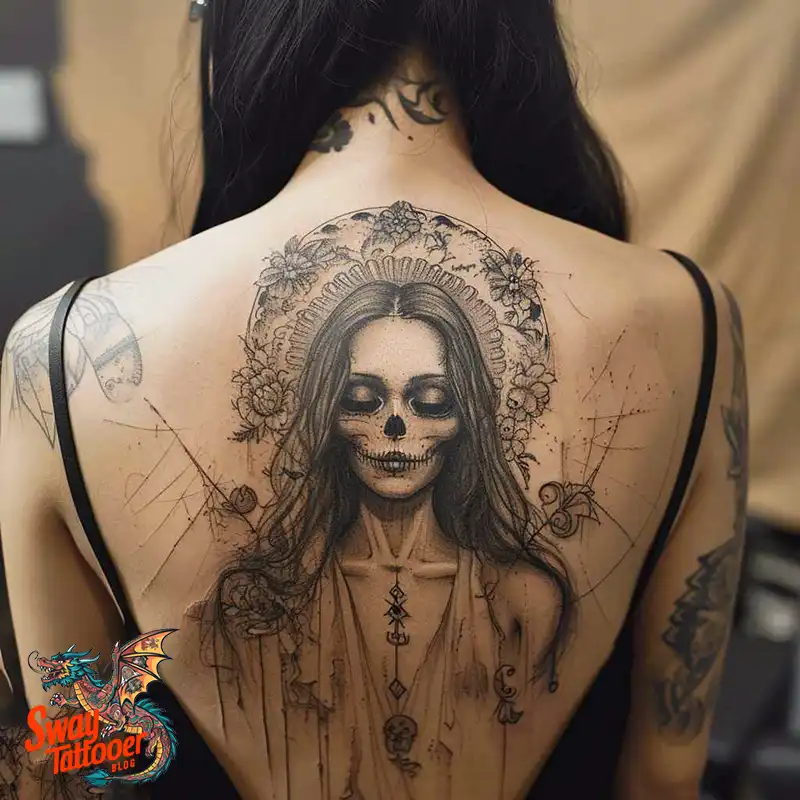
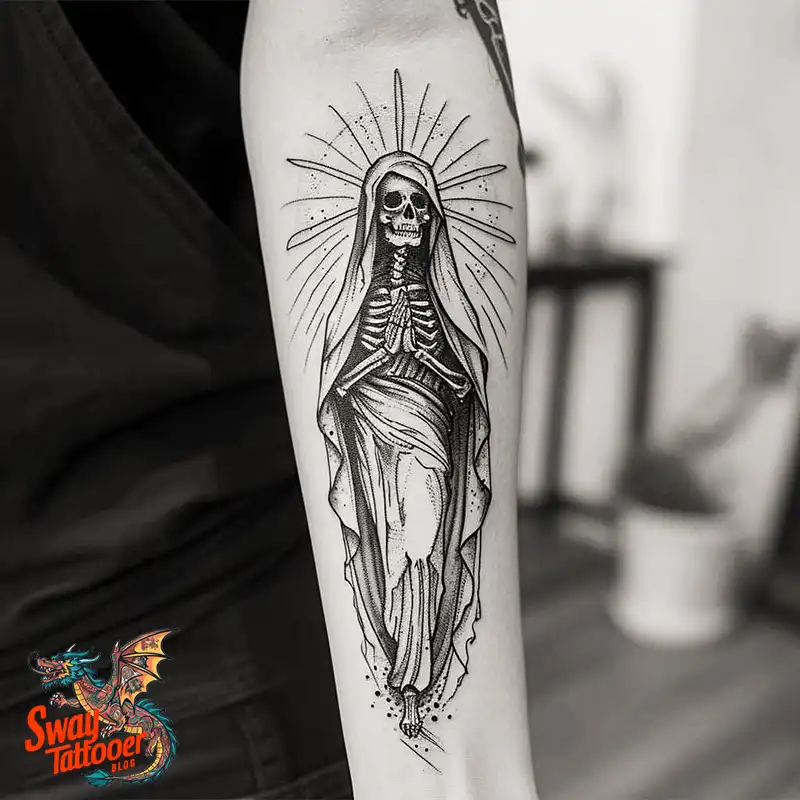

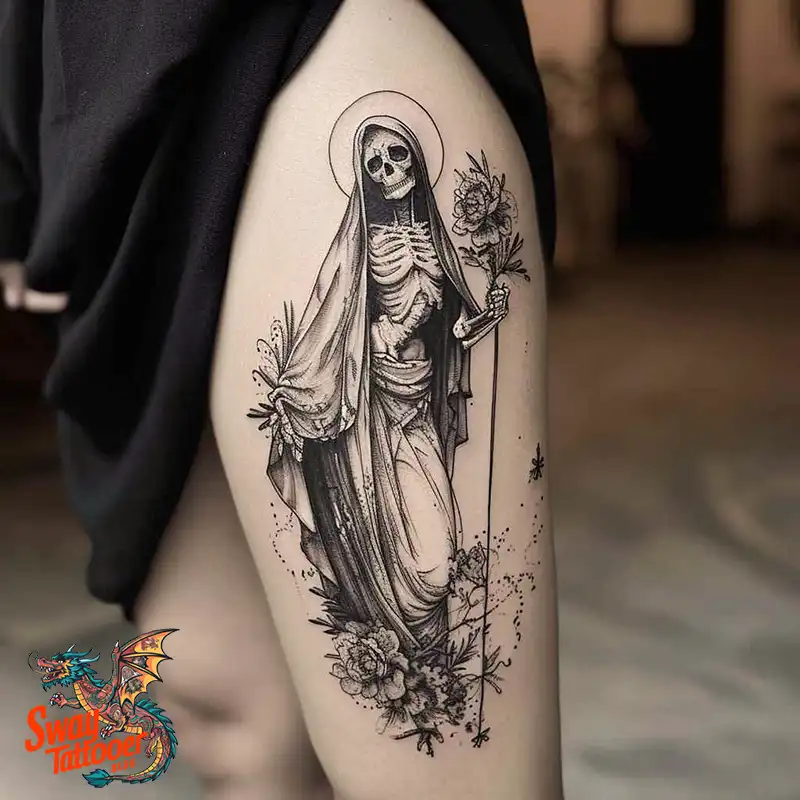
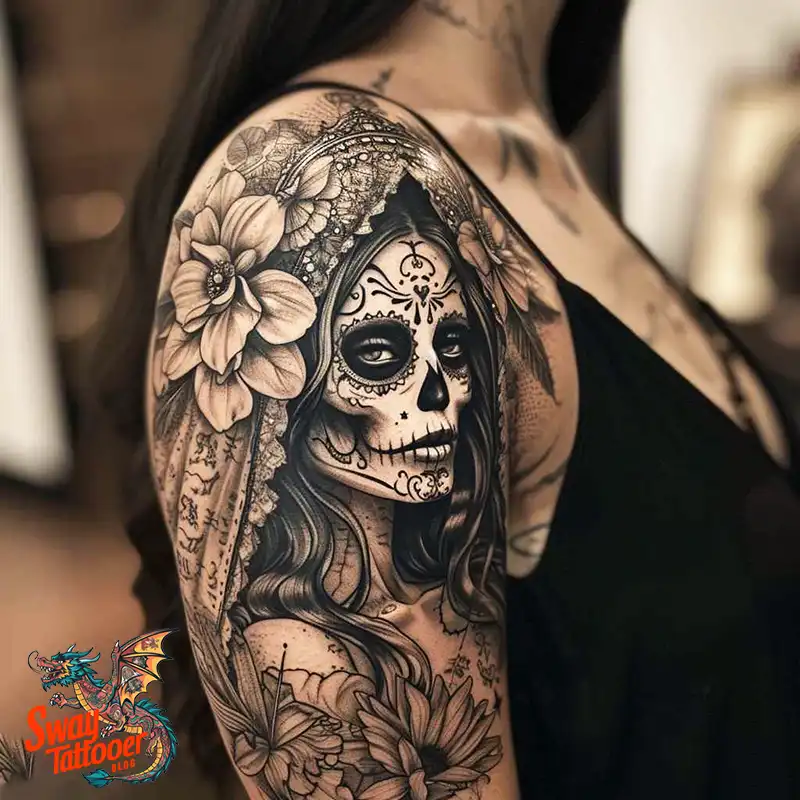
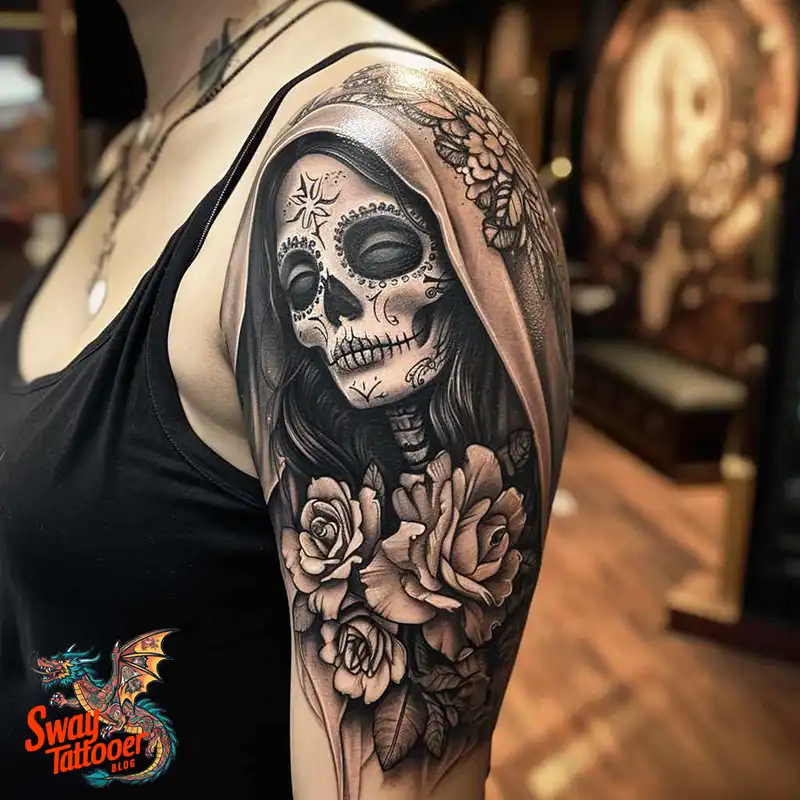
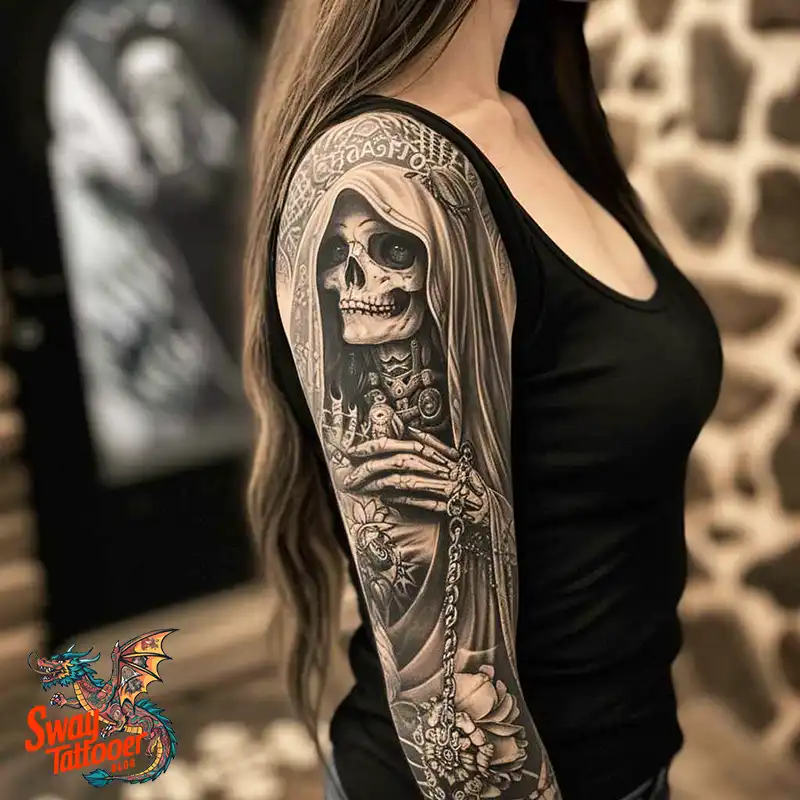
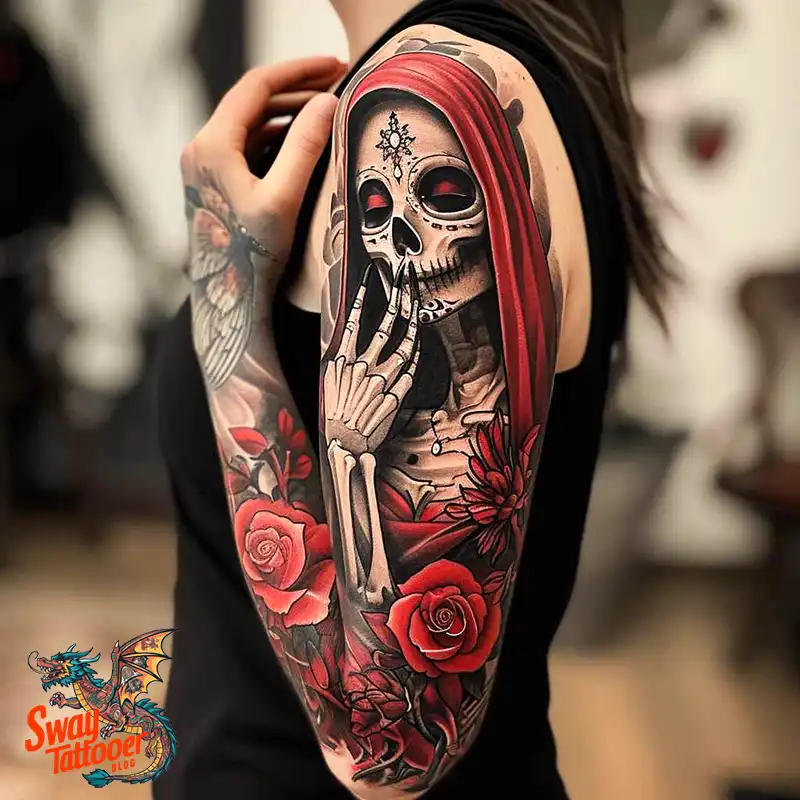
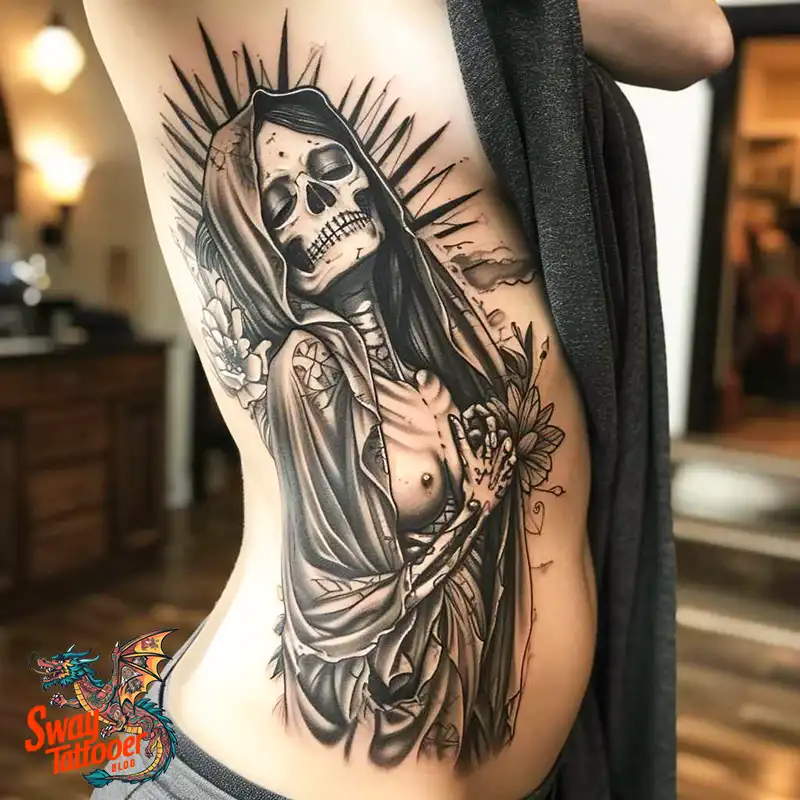
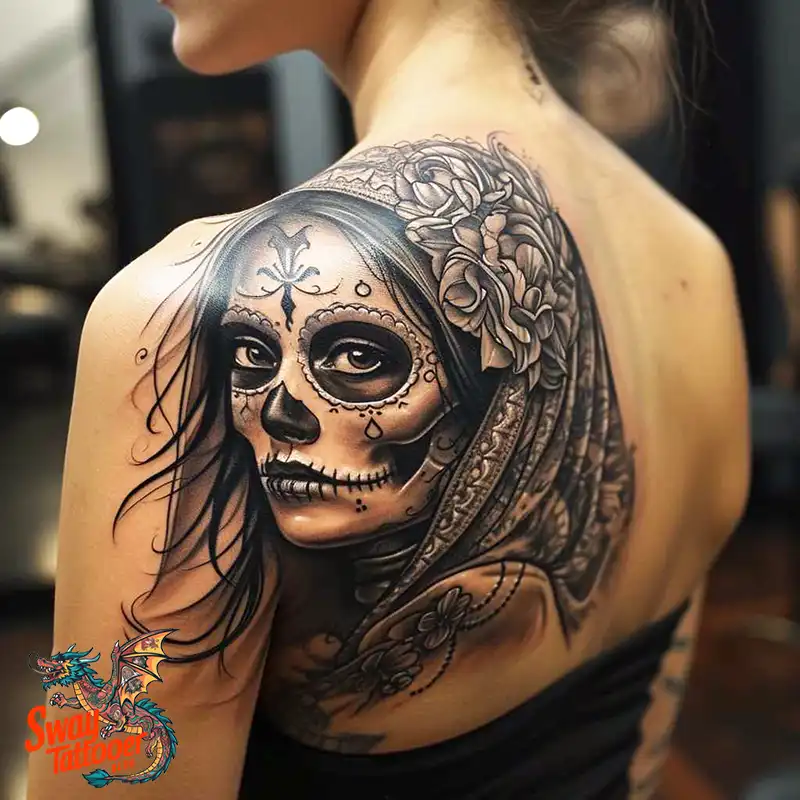
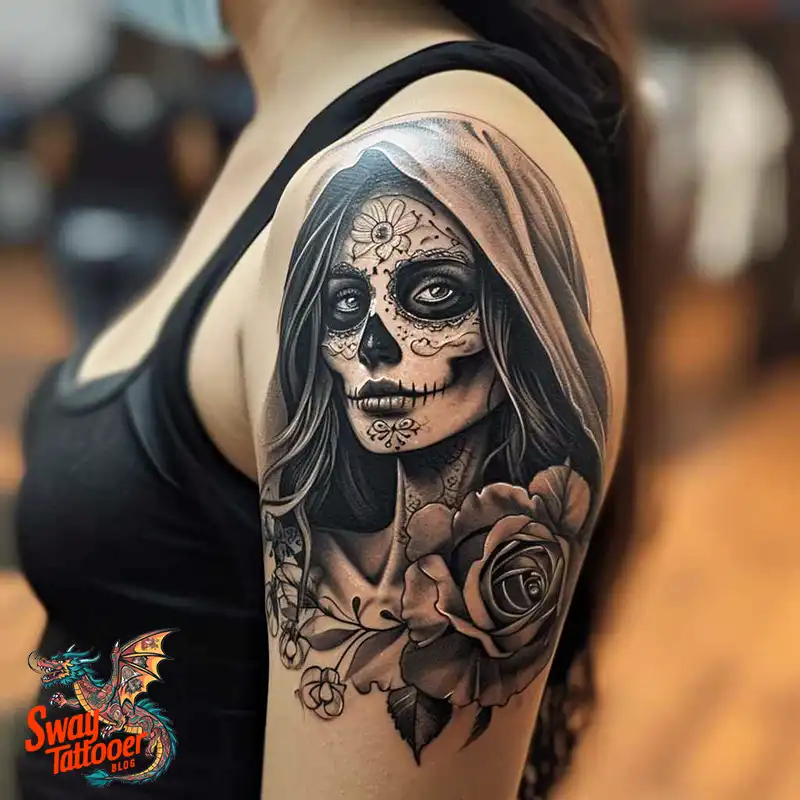
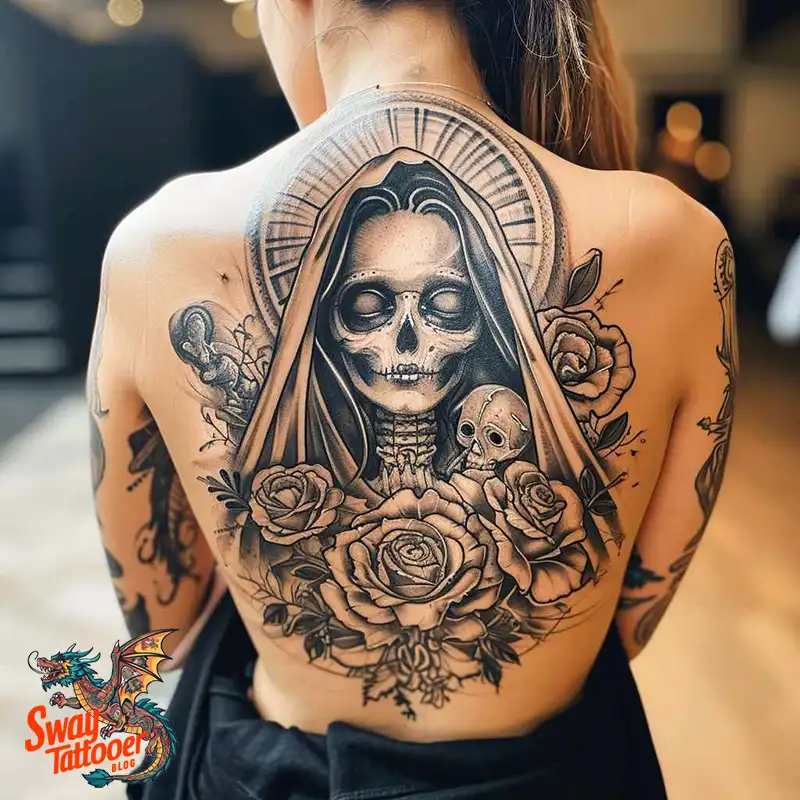
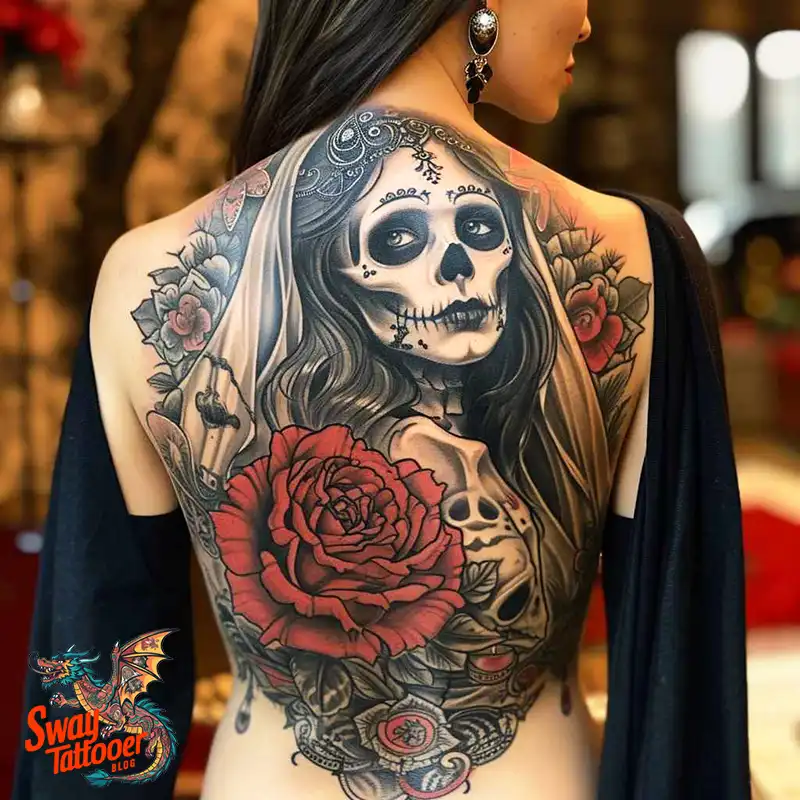
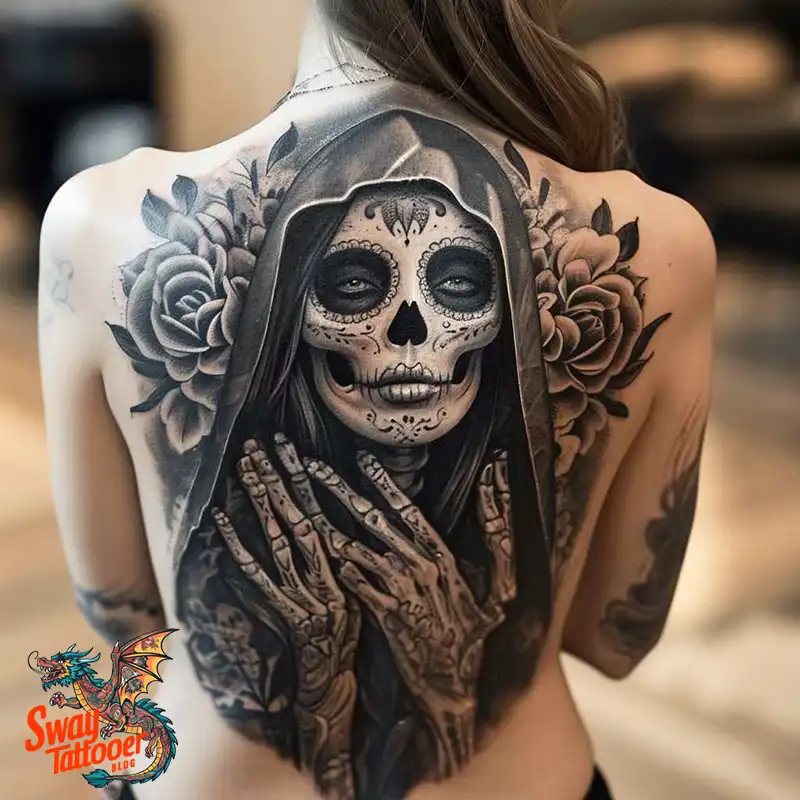
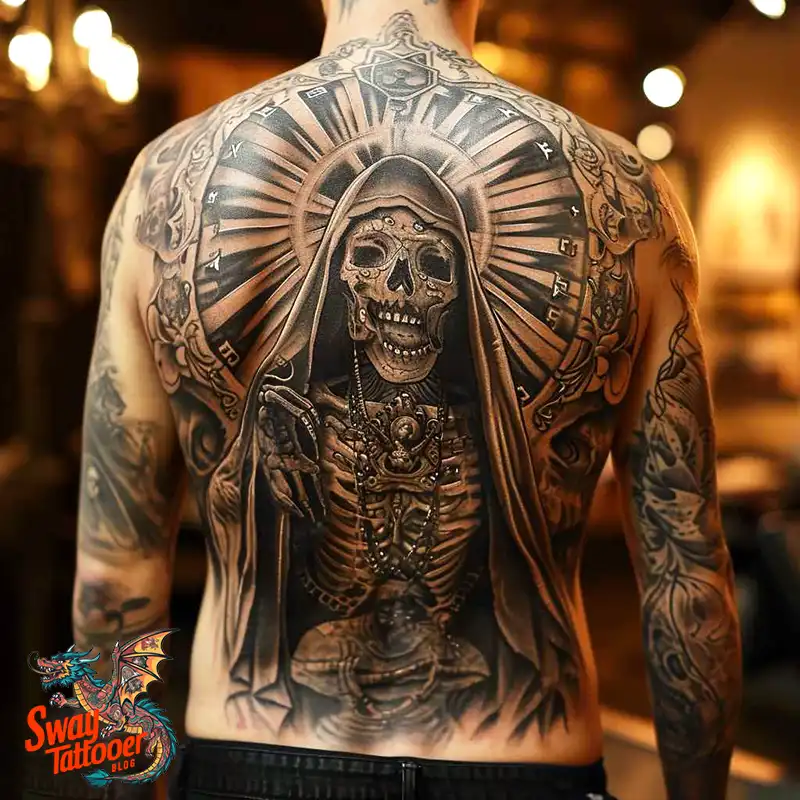
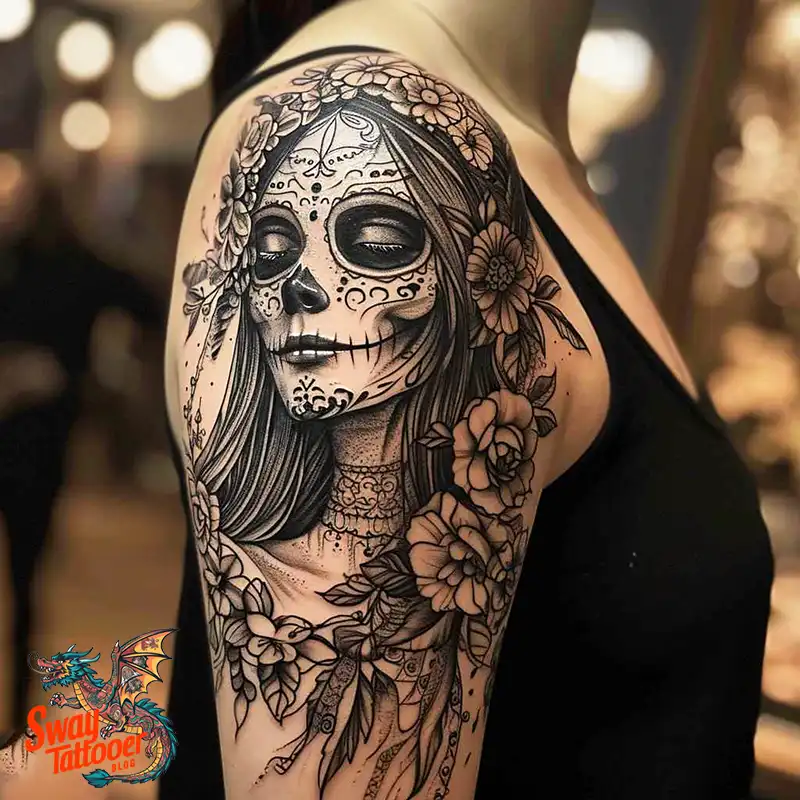
FAQs:
Frequently Asked Questions (FAQ) about La Santa Muerte Tattoos
1. What is La Santa Muerte?
Our Lady of Holy Death, or La Santa Muerte, is a religious figure who is venerated primarily in Mexico and some United States states. She is typically depicted as a skeleton, representing death, and is reported to offer protection, healing, and safe transit into the afterlife. Her devotees can ask for her blessings for all sorts of things, from living through personal affliction to exacting revenge.
2. What are La Santa Muerte tattoos a representation of?
La Santa Muerte tattoos can mean anything to the wearer:
- Protection: Many people get the tattoos as a form of spiritual protection against harm.
- Devotion: To some, the tattoo is a representation of their deep belief and devotion to La Santa Muerte.
- Acceptance of Mortality: The image can also be used to symbolize an acceptance of death and the transience of life.
- Strength and Resilience: The image can also symbolize strength and resilience to endure the challenges of life.
3. Are La Santa Muerte tattoos culturally sensitive?
Yes, La Santa Muerte tattoos are founded upon a specific religious and cultural context. Being respectful and mindful of this imagery is important. Individuals outside of this cultural background should educate themselves on it and pay attention to the meaning of the symbol so that they do not culturally appropriate and misrepresent it.
4. What are common designs for La Santa Muerte tattoos?
Common designs for La Santa Muerte tattoos are:
- Traditional representations: She is typically shown in a robe, with a scythe or globe.
- Vibrant representations: Tattoos employ bright colors, along with additional elements such as flowers, candles, and rosaries.
- High-realism: Highly realistic tattoos that are centered on the skeletal aspect and details.
- Symbolic elements: Including elements such as scales for fairness, clocks for the passage of time, or roses for love and beauty.
5. Where on the body are La Santa Muerte tattoos typically placed?
La Santa Muerte tattoos can be placed anywhere on the body, but most preferred locations are:
- Arm and Forearm: Appropriately suited for detailed, extended designs.
- Back: Has enough space for intricate and big designs.
- Chest: Typically chosen because it is close to the heart, symbolizing deep devotion.
- Legs and Calves: Well-suited for big and small designs.
6. Do I need to do any rituals before getting a La Santa Muerte tattoo?
There aren’t any that everyone must do, but some adherents may wish to enact personal or traditional rituals such as:
- Prayer: Prayer to La Santa Muerte for protection and blessing.
- Offerings: Offerings of candles, flowers, or incense.
- Meditation: Meditation on the significance and personal meaning of the tattoo.
7. Is it absolutely necessary to be a follower of La Santa Muerte in order to get tattooed?
While not a requirement, it is indeed recommended to learn about and pay attention to La Santa Muerte’s cultural and religious significance prior to having her portrait as a tattoo. For some, this is a deep expression of loyalty and faith, so it should be considered seriously.
8. What do I seek in a tattoo artist when getting a La Santa Muerte tattoo?
It is crucial to find the right tattoo artist. Look for:
- Experience: A tattoo artist with experience in religious or cultural tattoos.
- Portfolio: Browse through their portfolio to ensure that they can perform the design you desire.
- Reputation: Check reviews and feedback of previous clients they have worked with.
- Hygiene: Ensure that the tattoo studio maintains good hygiene standards.
9. What am I supposed to do with my La Santa Muerte tattoo now that it has been inked?
It is crucial to aftercare to ensure your tattoo heals well:
- Clean It: Wash the tattoo using soap and water.
- Lube It Up: Apply a thin coat of tattoo-specific cream.
- Stay Away from the Sun: Cover and hide the tattoo from sunlight.
- Follow the Artist’s Instructions: Follow any specific aftercare instructions provided by your tattoo artist.
10. Can La Santa Muerte tattoos be removed if necessary?
Yes, La Santa Muerte tattoos can be removed using professional methods such as laser tattoo removal. Nevertheless, the procedure is expensive, time-consuming, and even painful in some cases. It is crucial to thoroughly consider this commitment prior to obtaining the tattoo.
Through responding to these questions, we seek to provide an in-depth overview of La Santa Muerte tattoos, their symbolism, and what to look for for those who are interested in this profound expression of body imagery.
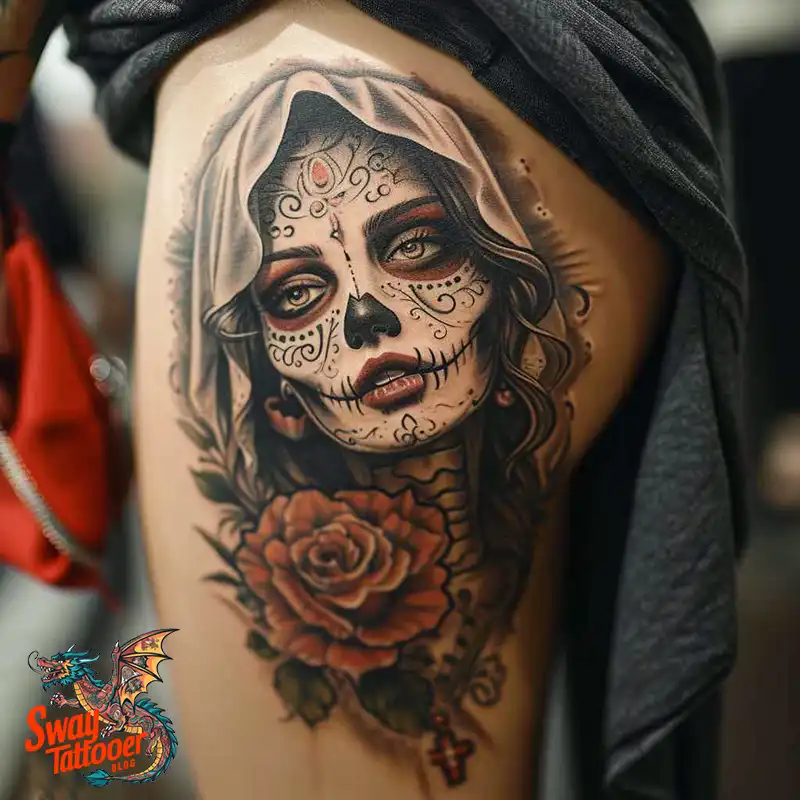
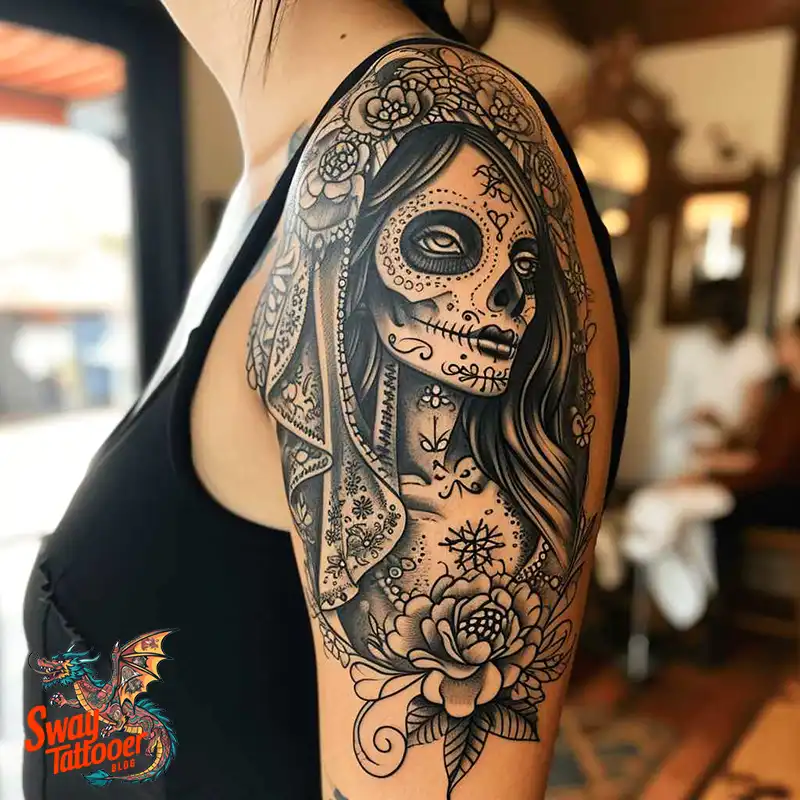
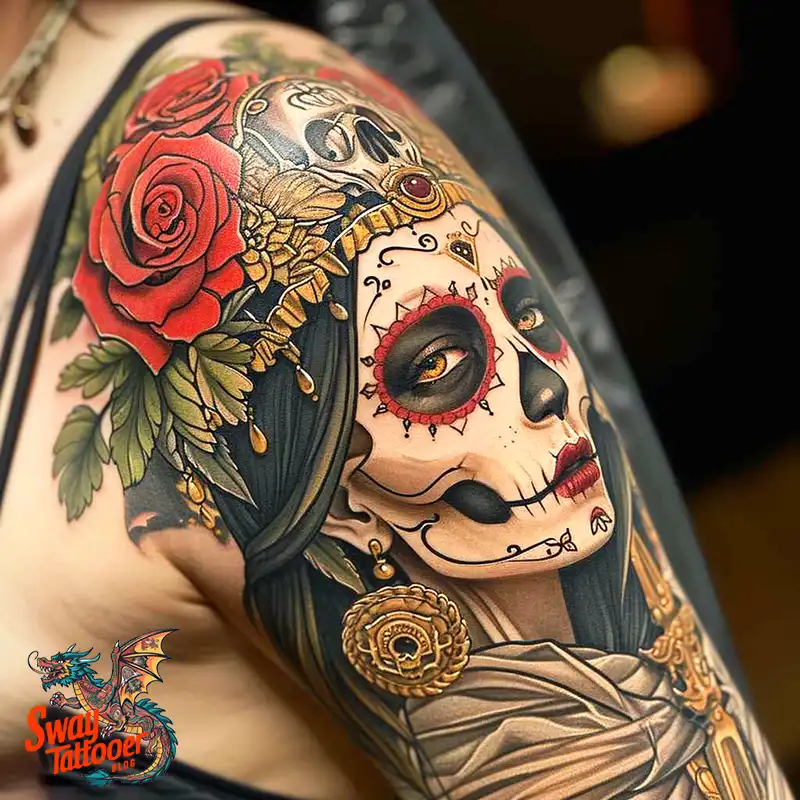
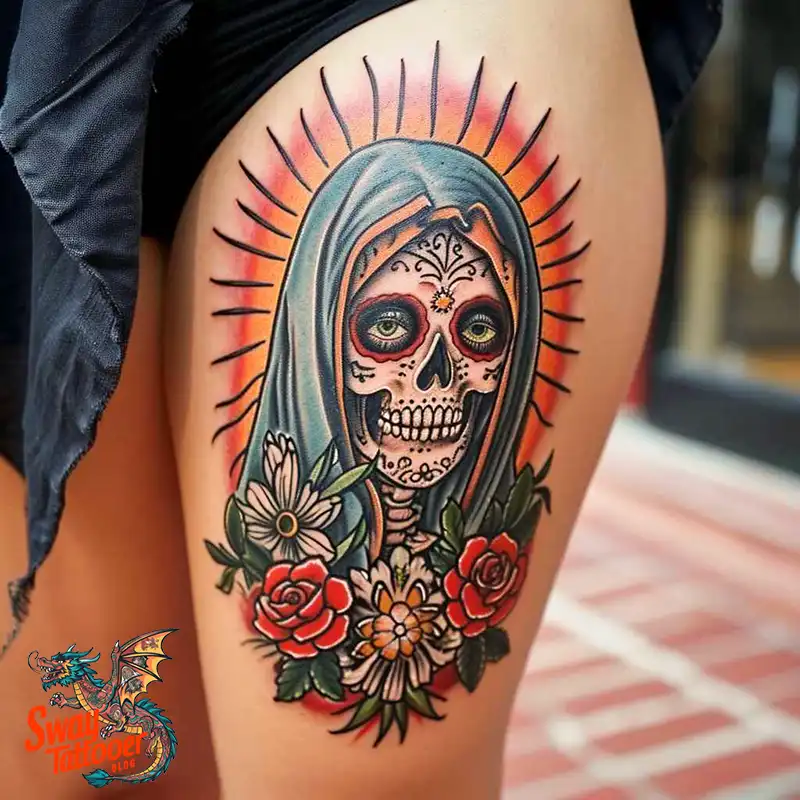

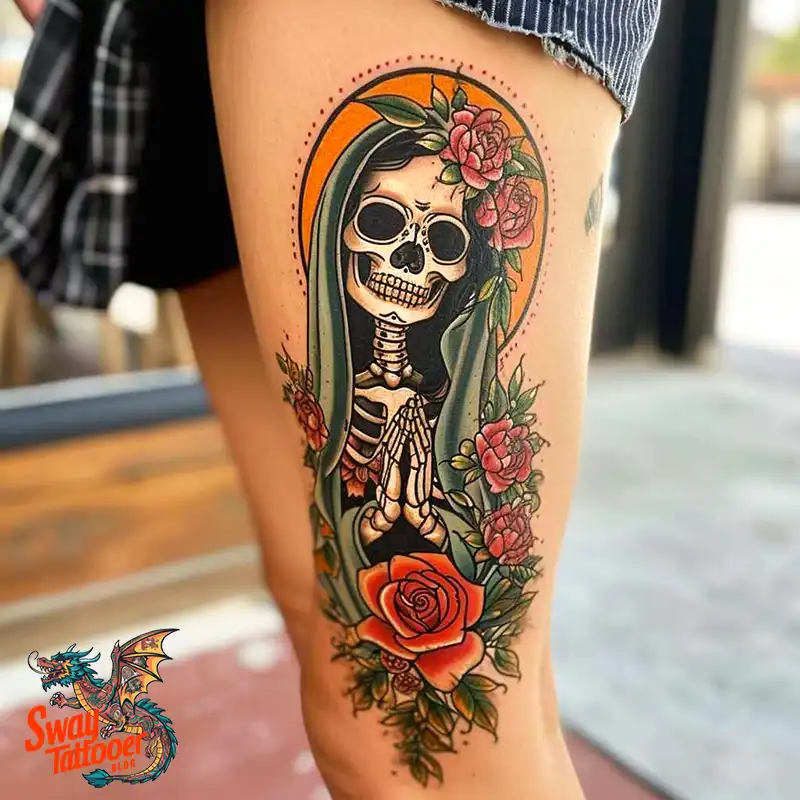
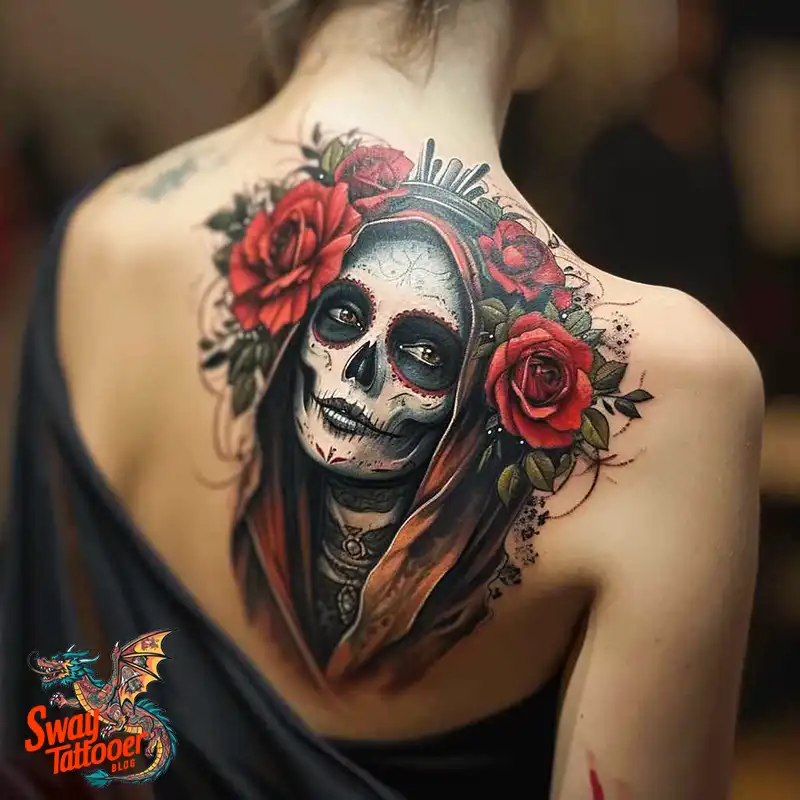

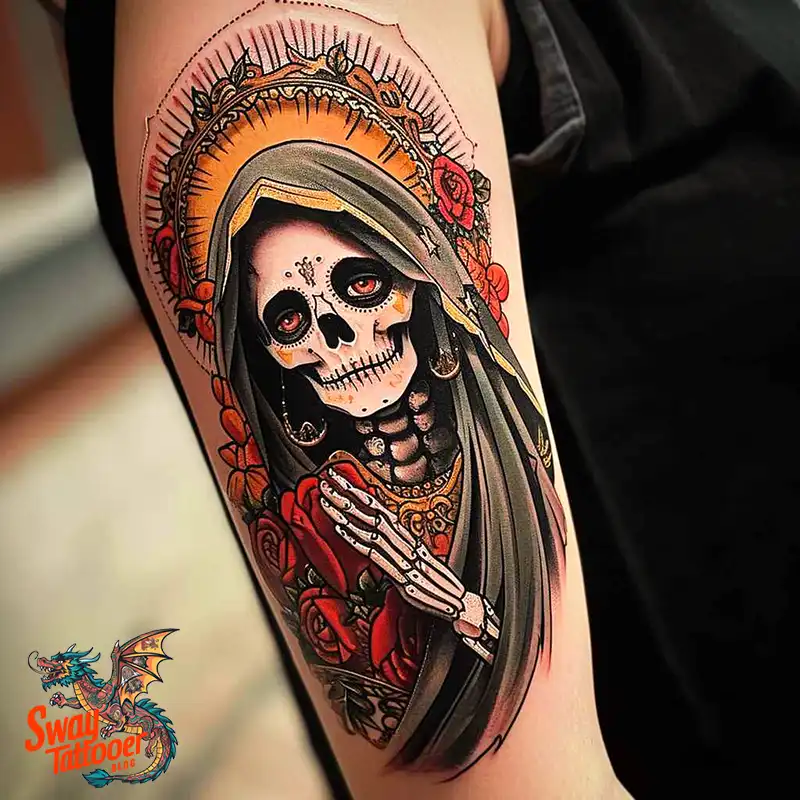
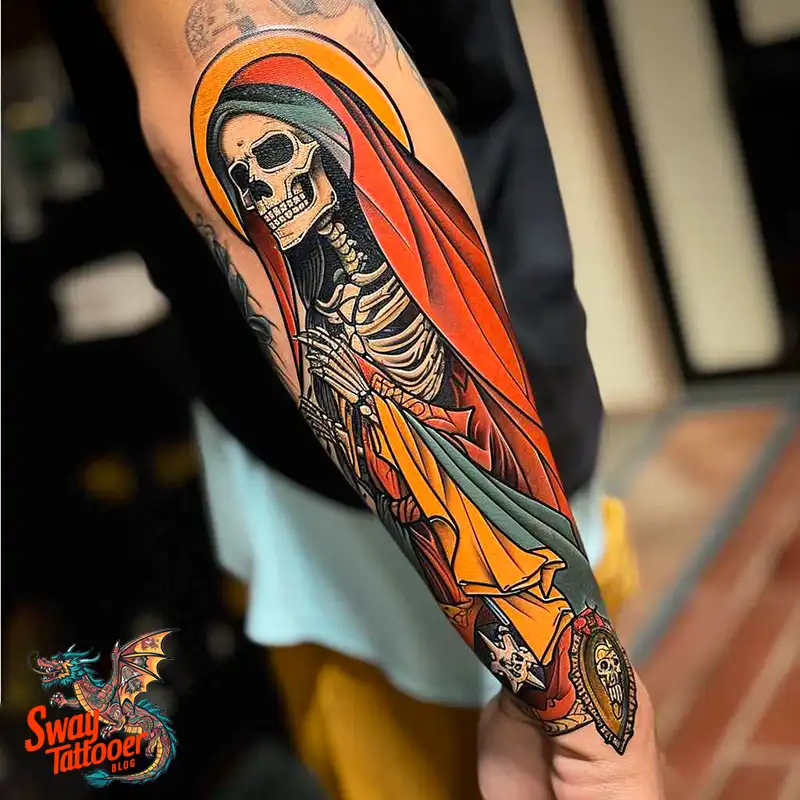

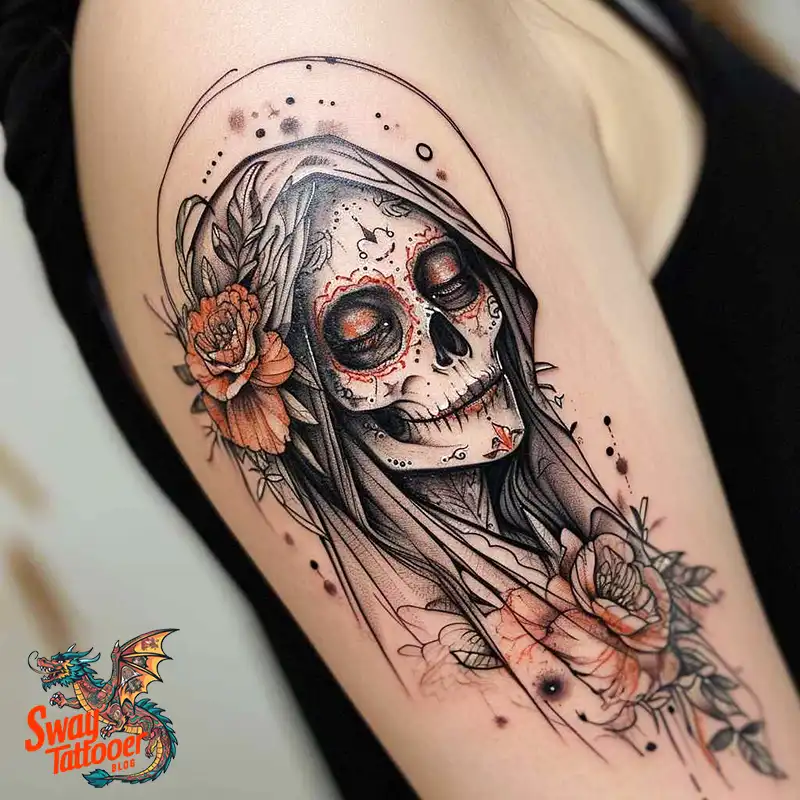
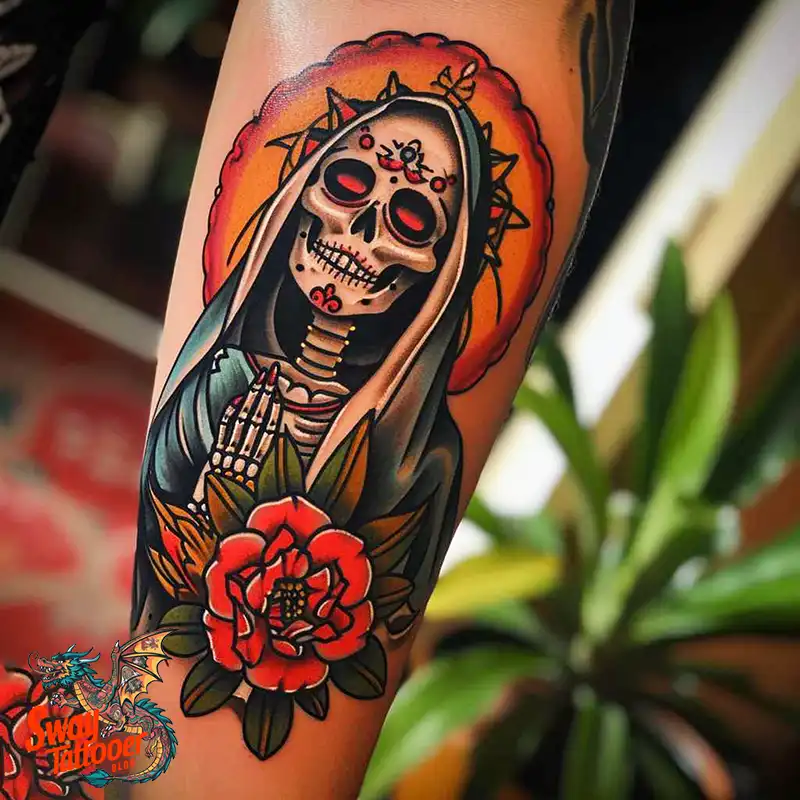
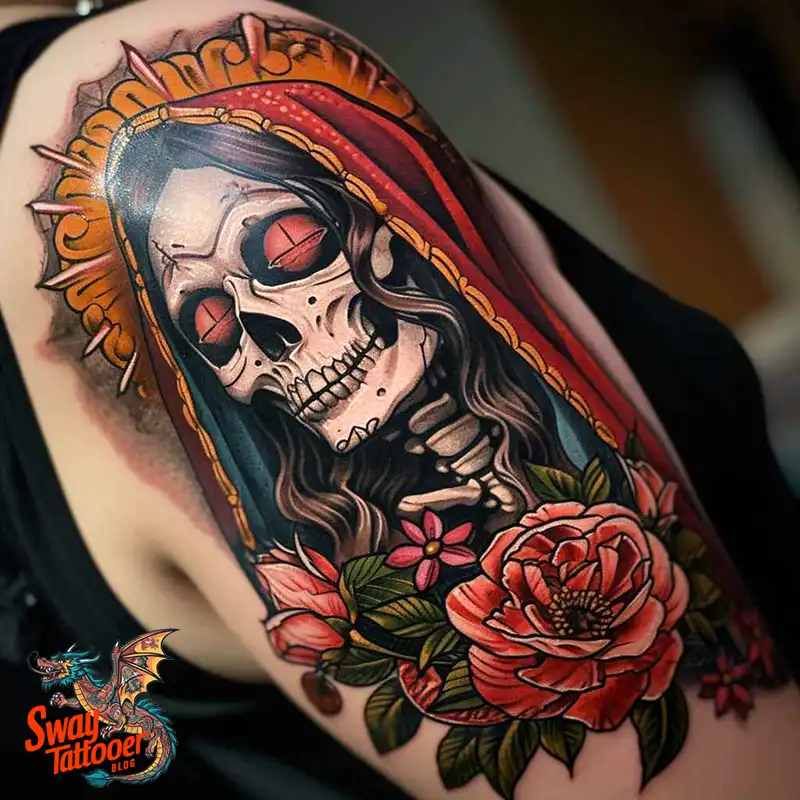
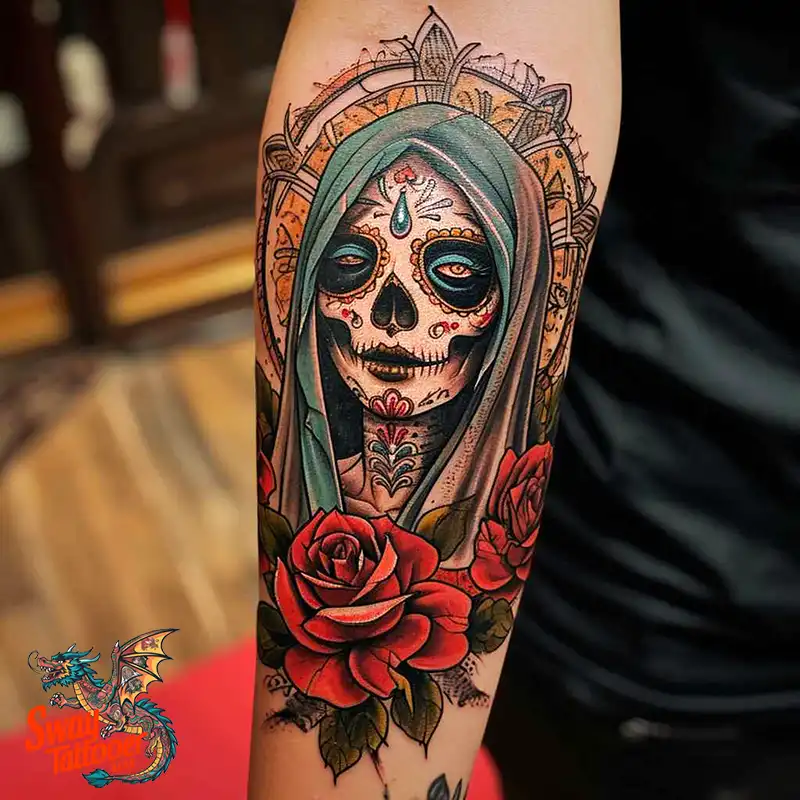
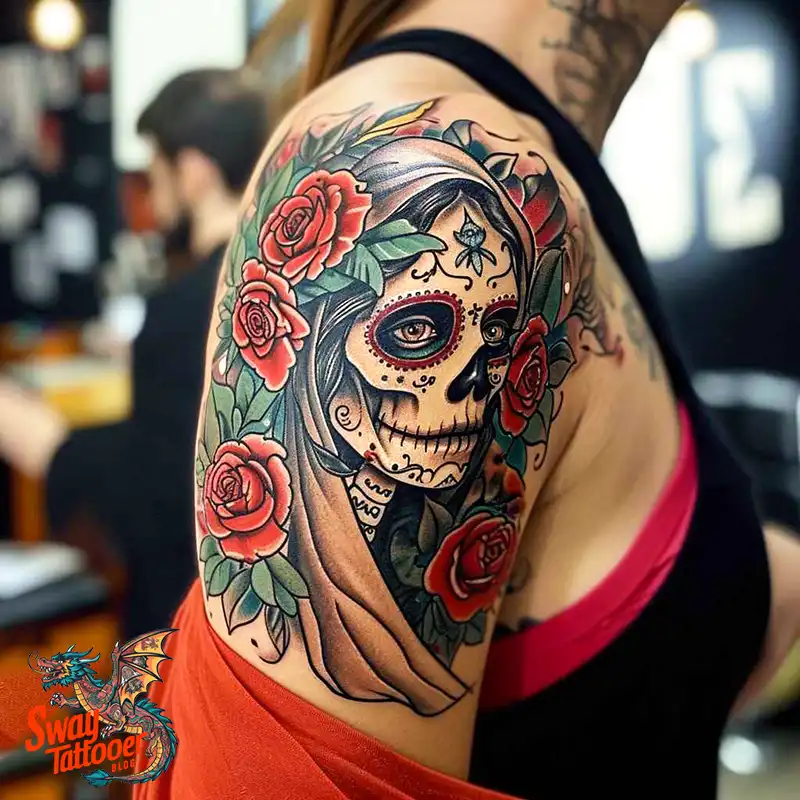
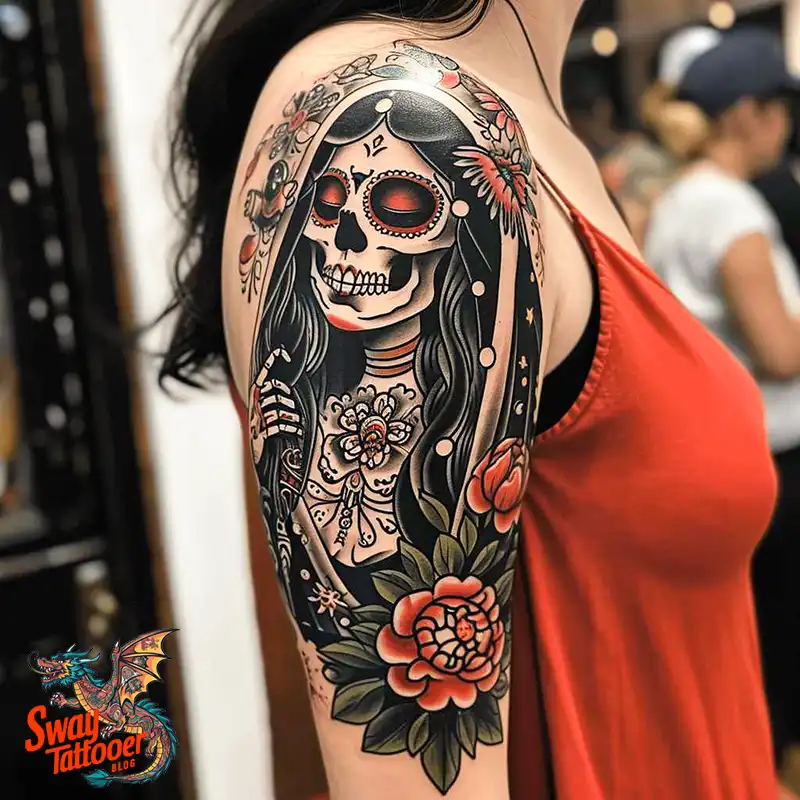
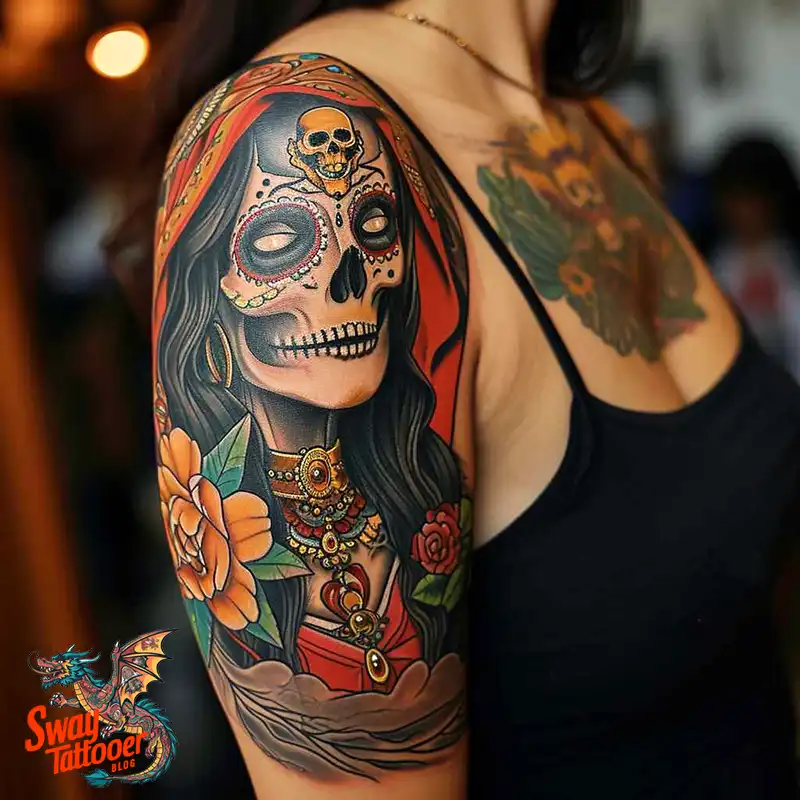
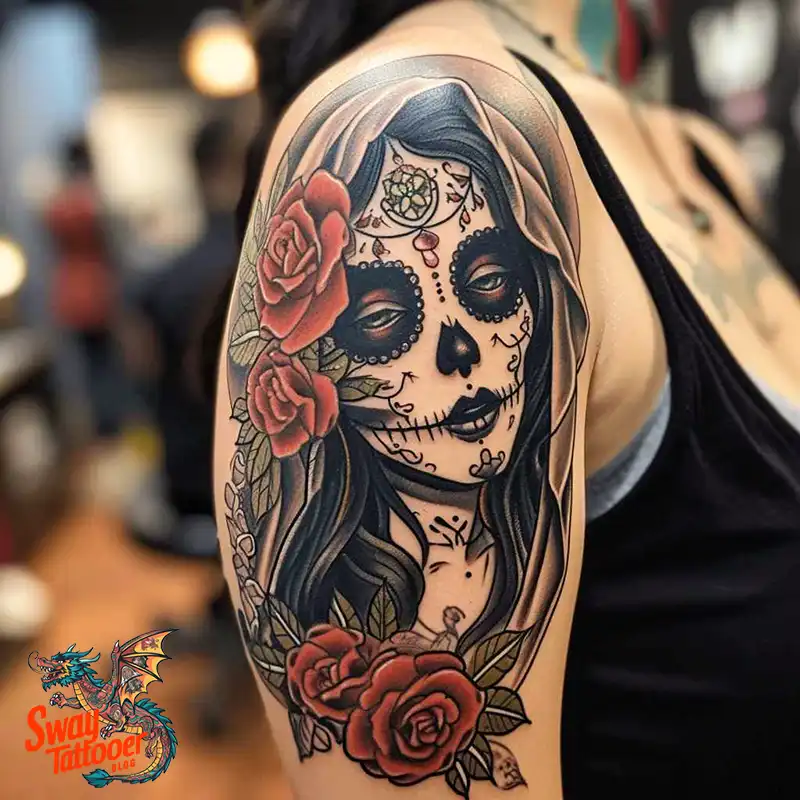
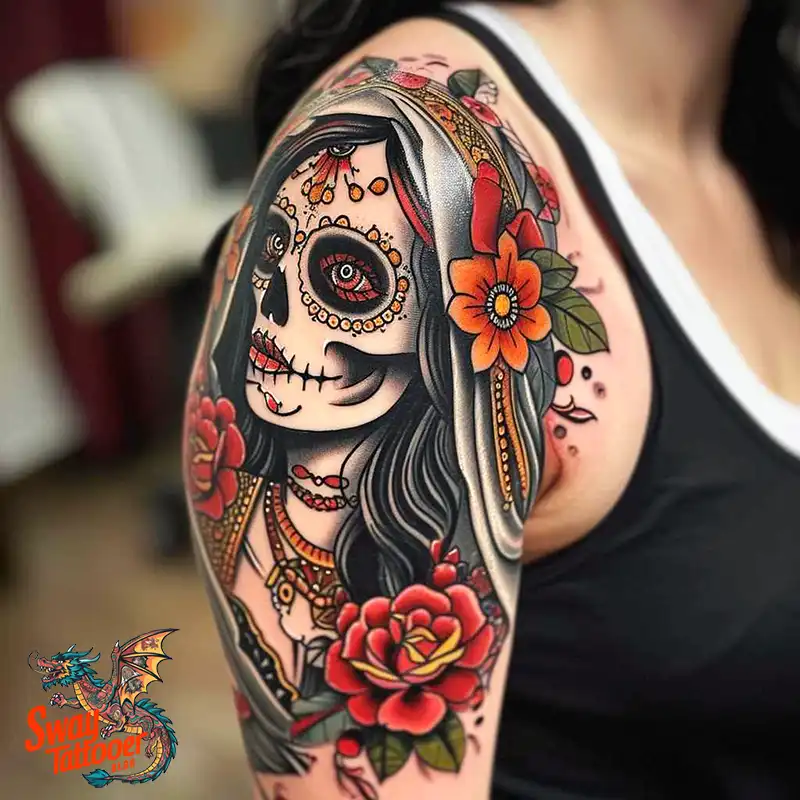
Conclusion
La Santa Muerte tattoos have deep cultural, spiritual, and personal meaning. We learned that La Santa Muerte started as a folk saint and grew into a symbol of strong death and protection in Mexican society and beyond. For many people, these tattoos give comfort, strength, and a connection to something divine.
We also looked at the symbols in these tattoos. They show her skeletal form, her flowing robes, and other signs like scales of justice, globes, and scythes. Each tattoo tells a special story about the wearer’s experiences, beliefs, and dreams.
People choose La Santa Muerte tattoos for many reasons. Some want protection and guidance, while others honor loved ones who have passed away. These tattoos can also be a bold way to show that you are different and full of personal power.
It is important to respect these tattoos. They are not just pretty pictures; they carry deep spiritual and cultural meaning. For those who get this tattoo, La Santa Muerte is seen as a strong, powerful figure that goes beyond our world.
In the end, La Santa Muerte tattoos mix culture, faith, and personal expression in a unique way. Whether you see them from afar or feel their meaning up close, these tattoos connect people with the divine and leave a lasting impression.


Leave a Reply